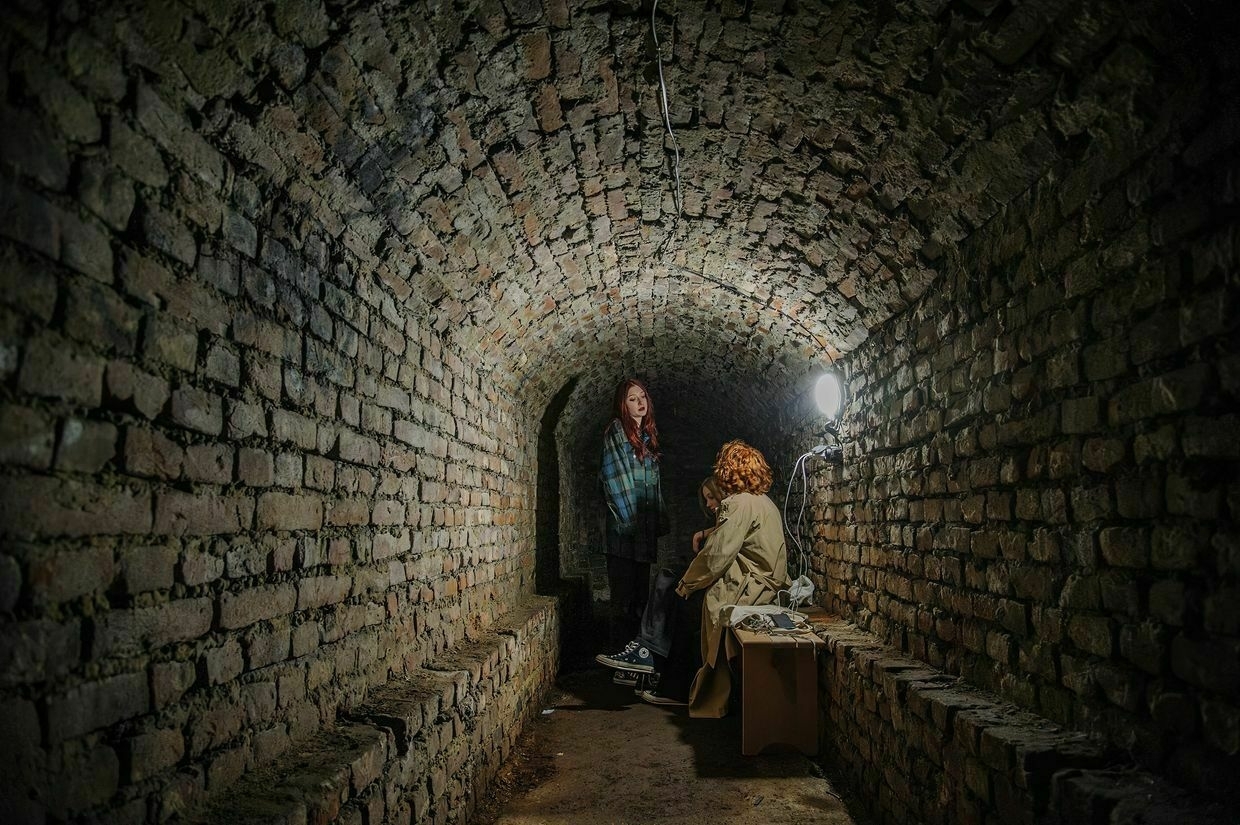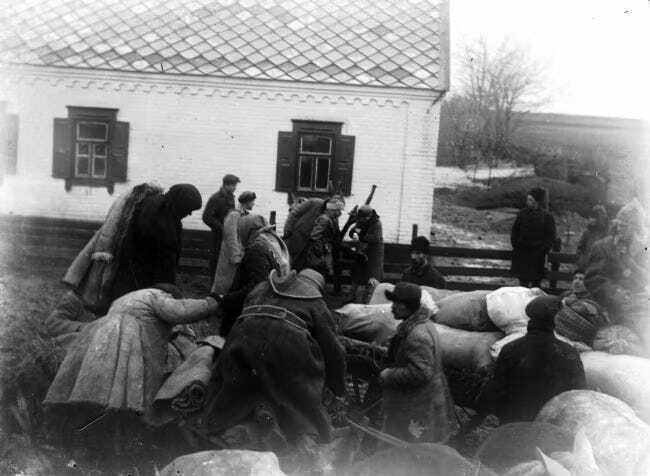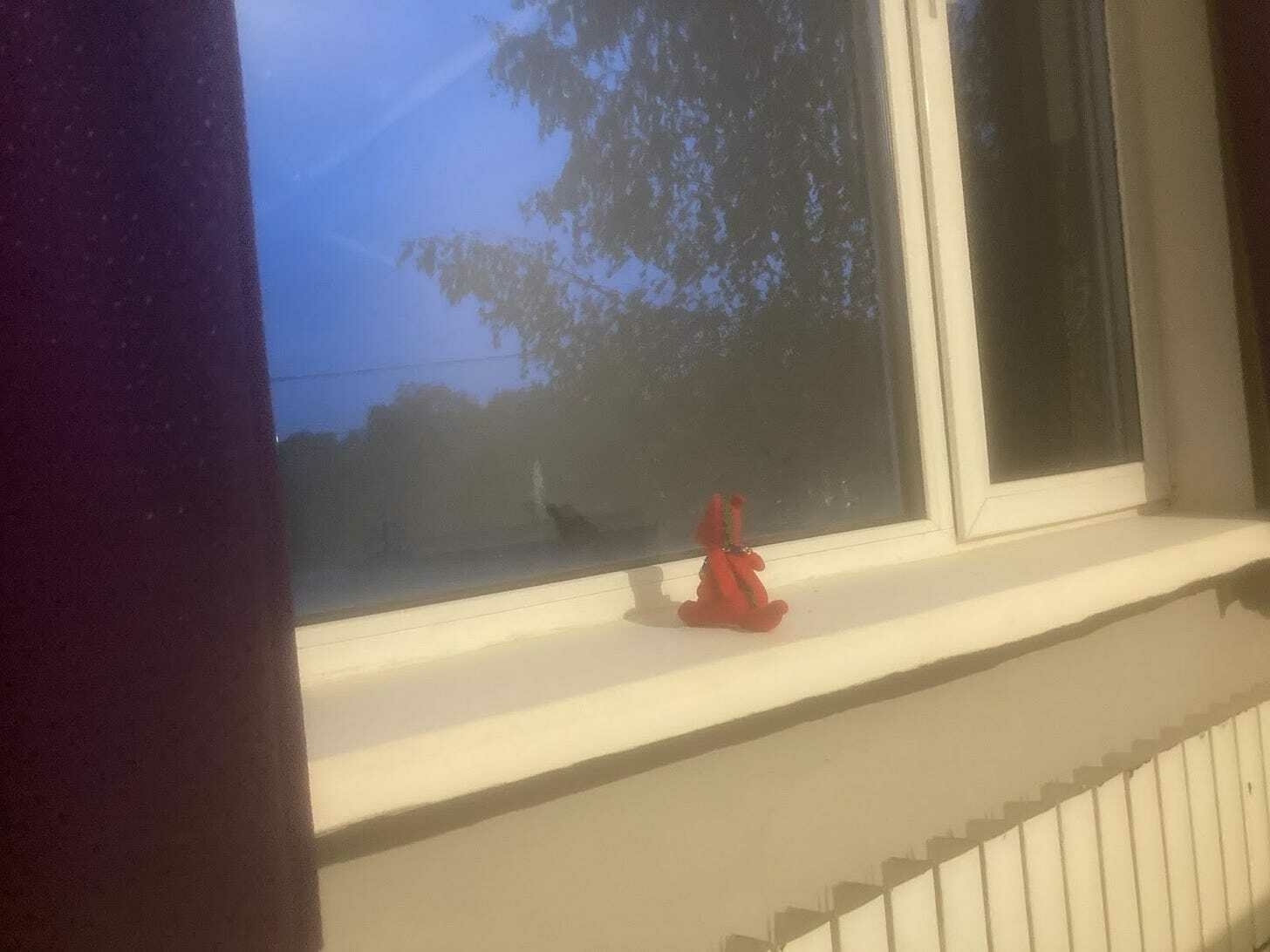-
Exchange of strikes! Russia terrorizes civilians, while Ukraine destroys military factories
-
Russian drone strikes hit Kharkiv: 64 injured, 3 killed
Russian forces launched a drone attack on residential areas in Kharkiv on June 11. The latest reports confirm that 64 people have been injured, with nine of them being children.
Ukrainian President Volodymyr Zelensky said that recovery efforts are ongoing in Kharkiv following the nighttime assault by Russian "Shahed" drones. The strikes targeted ordinary residential buildings. Tragically, three fatalities have been confirmed so far.
"Every new day now brings fresh malicious strikes from Russia, and nearly every attack is demonstrative. With each blow to ordinary life, Russia underscores that existing pressure is insufficient. There is a need for bold actions and new decisions that can create difficulties for Russia. Without this, they will not engage in genuine diplomacy. The United States and other global leaders have a significant role in this. Anyone advocating for a cessation of the violence and a diplomatic solution must take action," the President emphasized.
In Kharkiv, Russia deployed drones, sparking fires across two districts. Mayor Ihor Terekhov reported that the strikes hit a five-story residential building, igniting fires in 15 apartments. According to the Situation Center, Russian forces launched 17 drone attacks on the city. Additionally, the Russian military targeted the Odesa region. Overnight, social media reports mentioned hearing "Shahed" drones and anti-air defenses at work in the region. The State Emergency Service of Ukraine confirmed nighttime attacks on the Odesa region by Russian forces. These strikes led to the destruction and damage of summer homes, utilities, vehicles, and civilian watercraft. Fires broke out, which rescuers have since extinguished.
-
How Holodomor famine still scars Ukraine food habits
Editor’s note: June has historically been our toughest month, where we see a lot of unsubscribes.
Amid the constant attacks in Ukraine, we need your help: will you upgrade to a paid subscription to support our original work now?
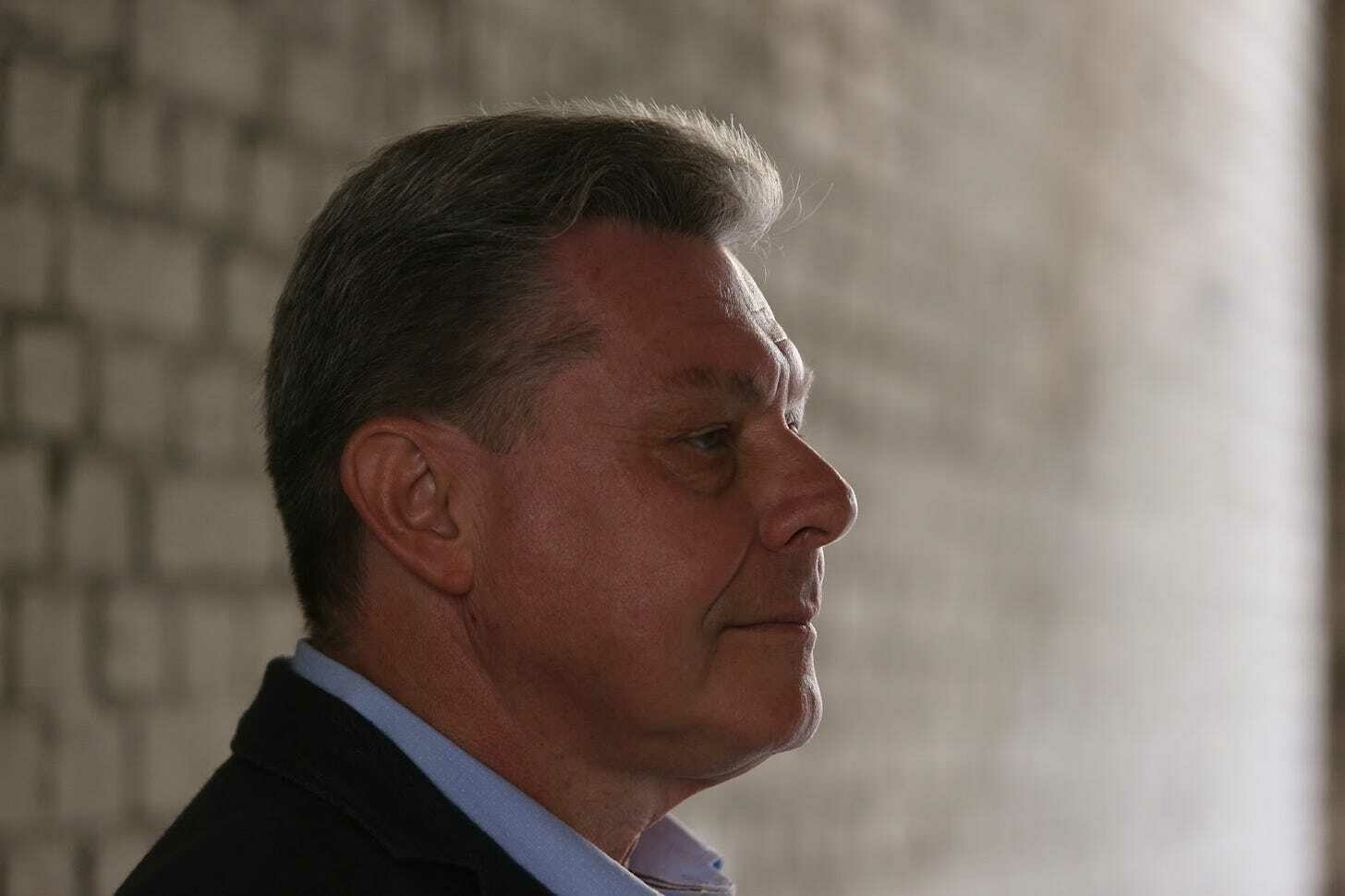
Oles Ilchenko, whose family survived Holodomor 1932-1933. (Photo provided by Oles to The Counteroffensive). “Instinctively, I catch myself on what I've been taught since childhood: that I have to eat up,” said Oles Ilchenko, a Ukrainian writer. “Sometimes I consciously stop.”
The rule of leaving no crumbs after a meal is still engraved in the subconscious of many Ukrainians. It’s just one of the scars still showing after a man-made mass famine in the Soviet Union in early 1930s killed about four million people.
More than 90 years later, the Holodomor remains deeply ingrained in the daily lives of Ukrainians and their meals. The instinct to never waste food – and the quiet joy of a well-stocked pantry – are traditions passed down through generations, as the trauma of starvation lingers in collective memory.
In Ukraine, preserving and rationing food has become a way of life, shaped by the legacy of the Holodomor. The canning and bottling of preserved food in basements was a critical reason why so many Ukrainians survive periods of occupation in the ongoing war.
And the tool of hunger as a weapon of oppression echoes today, as Russia’s military continues to starve Ukrainian prisoners of war.
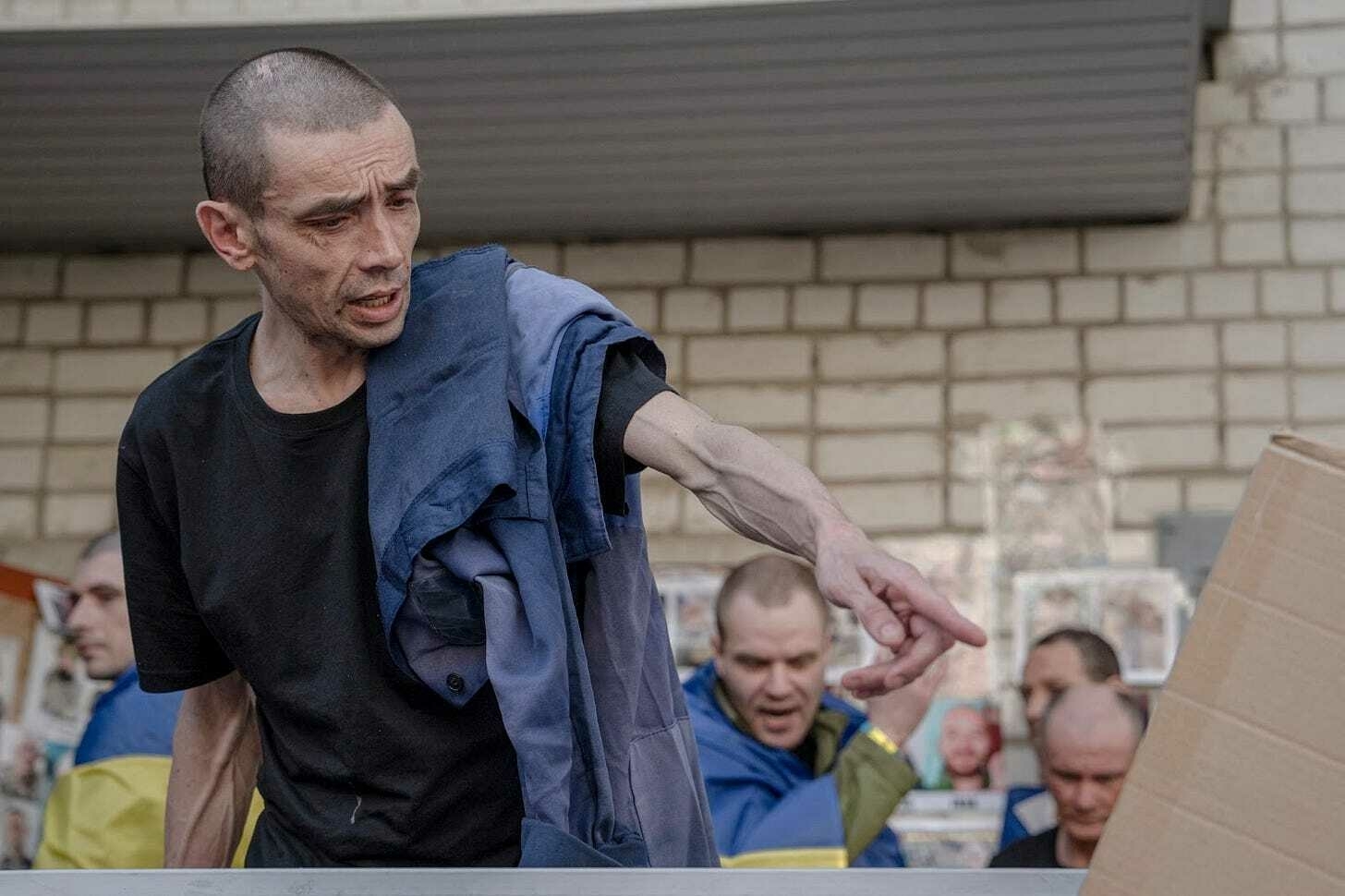
A POW gestures toward portraits of missing or captured servicemen, during the arrival of freed Ukrainian POWs after a prisoner exchange on June 10, 2025. (Photo by ANDREW KRAVCHENKO/AFP via Getty Images). Oles Ilchenko, 67 years old, is a Ukrainian writer, artist, and teacher at the first Ukrainian school in Geneva, Switzerland. He was born in Kyiv and spent most of his life there.
As a young teenager living in Ukraine, he would hear his family tell vivid stories about their experience during the Holodomor. His mother was reluctant to share, but his grandmother was an open book. Oles’ family lived in Ukraine’s central village of Kerelivka (Shevchenkove), in the Cherkasy region, during the Holodomor.
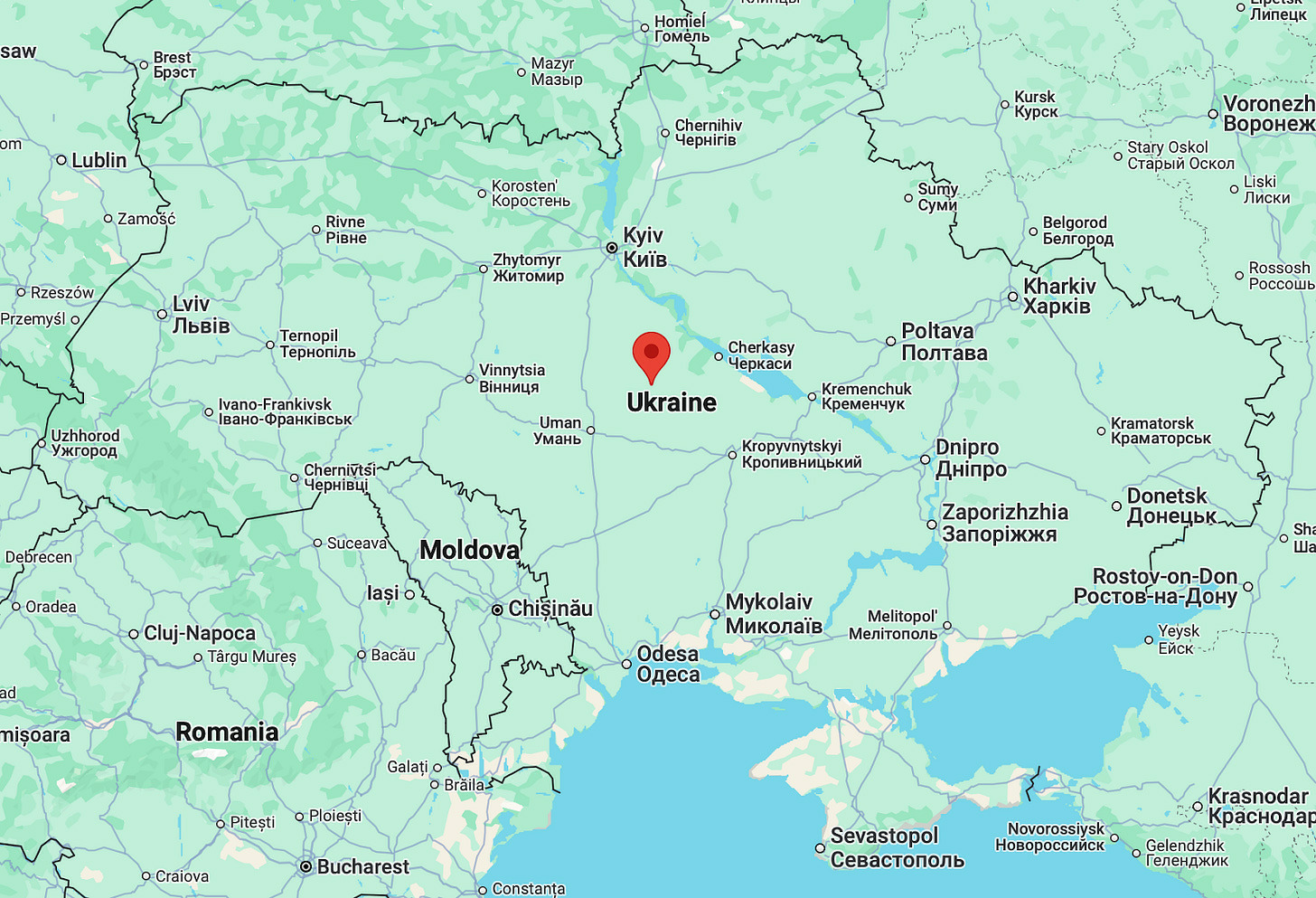
The village of Kerelivka (Shevchenkove), Cherkasy region, where Oles’ relatives lived during the Holodomor. (Screenshot from Google Maps). Oles moved to Switzerland in 2011 due to his wife’s job. Although he’s been away from Ukraine for 14 years, the experiences of his relatives still haunts him.
“I still can't watch them [Europeans] in a restaurant or a cafe, getting up, dropping everything – taking a bite of some cake, not liking it – because they didn’t want to eat it,” he said. “It still somehow doesn't leave me indifferent.”
Now, he tries to stop himself every time the old habits kick in, which can include overeating or feeling guilty over wasting food.
Oles has done everything he could to avoid passing on these traumatic habits to his now 35-year-old son. He claims to have never forced him to finish his meals, which is something his parents would make him do:
“Finish it all, don't leave it, you can't throw it away,” Oles recalled his relatives telling him when he was young. The forced feeding – often an unhappy memory in and of itself, was a reflection of a mentality that it is better to eat now because there may be no food tomorrow.
“[Even when] the child doesn't want to eat anymore, [he was forced] to eat.”
Even today, Ukrainian prisoners of war are tortured with starvation by Russian forces, violating all the norms outlined in Article 26 of the Geneva convention – a chilling echo of the same weapon once used by the Soviets. Many soldiers return exhausted not only from the physical torture they endure, but also from the lack of proper nutrients they receive.
Foreigners visiting Ukraine have been surprised by Ukrainians’ relationship with food.
“One of the things that struck me the most was how people don't waste food, like no one will throw bread away, particularly bread,” said Felicity Spector, a British journalist and author of the book ‘Bread and War’.
For Ukrainians, bread is sacred. It is ‘vsomu holova’ (‘head of everything’), ‘sviatyi’ (‘holy’) and ‘Bozhyi dar’ (‘God’s gift’).
During the famine and the years that followed, when there was nothing sweet to eat, Ukrainians would make bread with butter or honey on top, or simply wet a slice of bread with sugar. If bread becomes stale, it can be made into croutons that can be added to a soup or salad.
Before the Soviet Union, traditional Ukrainian bread was made of sourdough and grain.
The Holodomor was a man-made famine in Soviet Ukraine, caused by Stalin’s policies to suppress anything un-Soviet, targeted Ukrainian farmers through forced collectivization and grain seizures. Millions died in 1932-1933, and the famine is now widely recognized as a delibarate act of genocide intended to break Ukrainian resistance and identity.
On August 7, 1932, the so-called 'Law of Five Ears of Grain’ was adopted, which stated that ‘stealing’ common property, which could even mean picking up grain from the ground, could lead to confiscation of property or even execution.
Amid the new law, people could no longer cook or buy grain bread, as there was a lack of ingredients. Innovative cooks made bread out of peas, corn, acorn shells, or potato scraps.
Oles remembers how the imitation bread of the 60s, bought from the store, “tasted very bad and it was falling apart.”
Even years after the Holodomor ended, bread shortages persisted due the failure of collective farms. Oles’ father once went on a business trip to Leningrad, now known as St. Petersburg, and brought back two highly-coveted loaves of bread as a gift.
“And I remembered those two loaves so much, how we didn't know how to eat them or what to do with them,” Oles said. “And it was 1963, 30 years after the Holodomor. But the memories were so fresh, and everyone was really afraid that it would happen again.”

Oles’ grandfather, Zakhar Ilchenko, his grandmother, Mariia Kovalenko, and his mother, Diana Ilchenko, before the Holodomor. (Photo provided by Oles Ilchenko). For grandparents triggered by the horrors of famine, kids are never full.
“Grandparents look and see how thin he [a child] is, ‘we need to feed him more’,” said Vitalii Klymchuk, a Ukrainian therapist and Director at Mental Health. Even doctors sometimes tend to comment on a child’s weight, he said.
During phone calls, the first question from grandparents is usually: “Have you eaten?” or “Are you hungry?” These small details can be traced back to the time when feeding a child meant keeping them alive.
When the Holodomor started, Oles’ grandmother, Mariia Kovalenko, was a young mother. People ate whatever they could find or hide.
“My grandmother told me that they hid a bag of dried cherries in the attic and ate them secretly at night,” Oles said. “And that's how they survived.”
In the 1920s, a grain procurement crisis arose when farmers refused to sell grain at a discounted price to the USSR. Amid the crisis, Soviet leaders imposed the collectivization of the agricultural sector in 1929, forcing people to enroll in ‘kolkhoz’ – collective farms. The policy was aimed at wealthy peasants who disagreed with the grain prices – 113,000 of them were later deported.
Approximately 70 percent of peasant farms were collectivized – roughly half of the population of Ukraine at the time. The Soviet leadership thought the initiative would increase the food supply. But by beginning of 1932, every farmer was experiencing hunger.
“It was insanity, cannibalism, and degradation when they [people during Holodomor] ate roots, leaves, and bark,” Oles said. “This is simply reducing a human being to the level of an animal that only thinks about what to eat, and cannot think of anything else.”
There were more than 2,000 criminal cases of cannibalism during 1932-1933, according to Mykhailo Kostiv, Head of the Department for the Study of Genocide, Crimes Against Humanity and War Crimes.
Oles was shocked by a story his grandfather told. Perhaps it was a rumor, perhaps it was true. But it showed the sort of lives these people lived: A woman became so desperate that she killed a child and boiled it. She was shot on the spot by authorities.
Such horrors transformed food from a mere substance to something to be coveted and preserved. Ukrainians have long found ways to reuse spoiled food instead of discarding it. If milk starts to sour, for example, they can make other dairy products, such as kefir (a thin yoghurt) and cheese.
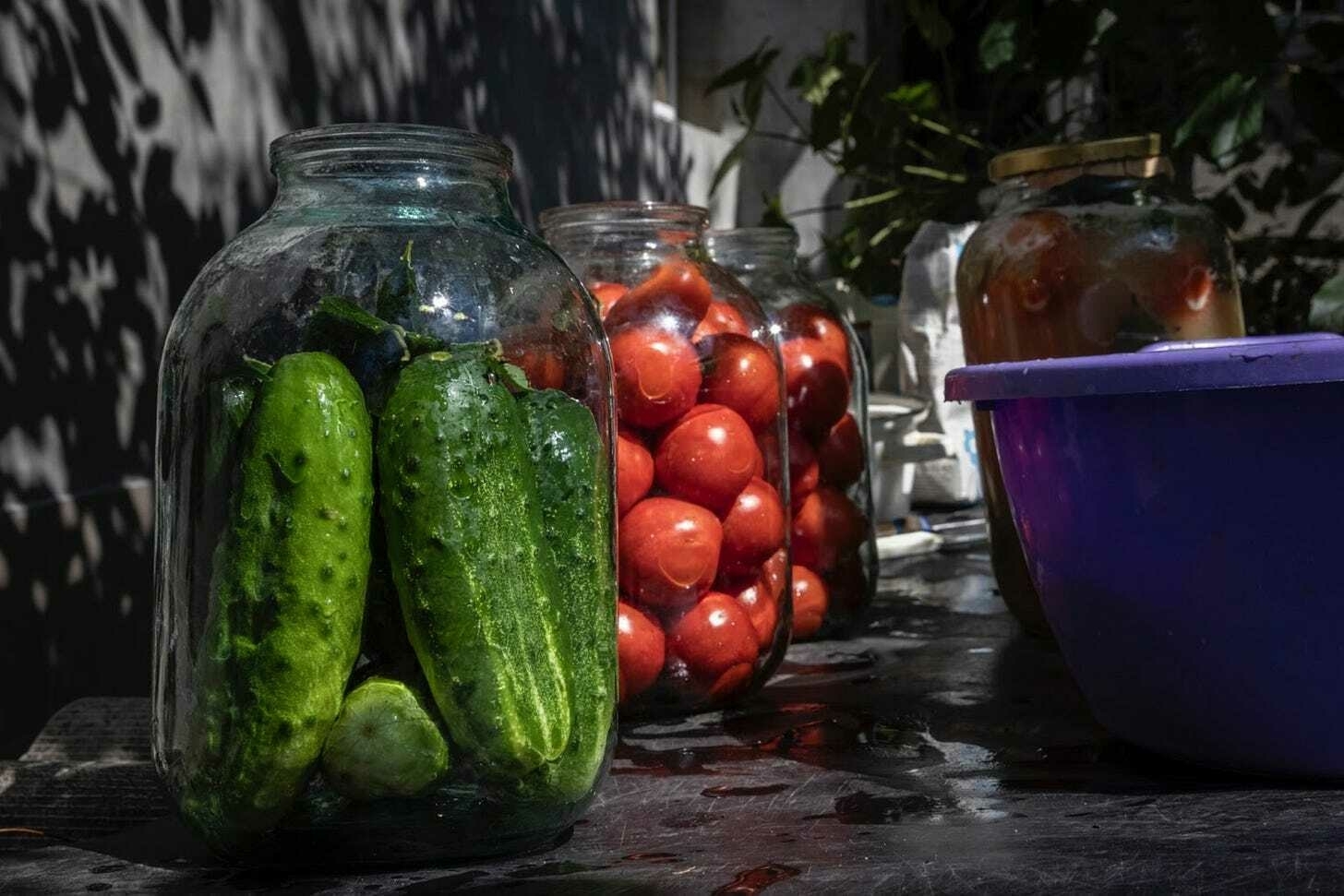
Traditional Ukrainian pickling season starts in mid summer as fruit and vegetables grow ripe in mineral rich soil and the home-grown produce is harvested and preserved in large jars. (Photo by Ed Ram/Getty Images). “It becomes clear why all families, Ukrainian ones, had such fantastic winter preparations,” Oles said, adding that they all kept jars of pickles, fermented foods, jam, and jelly in storage. “And these jars were in incredible numbers, you couldn't eat them all.”
Oles’ grandmother even stored jars filled with every “imaginable and unimaginable” type of fruit for years. Nowadays, even with access to supermarkets, Ukrainians continue to store food this way. The majority of Ukrainians living in villages, in houses with cellars, use this method to prepare for winter.
A Ukrainian family that Oles knows, who has lived in Geneva for the past 20 years, also stores food in preparation for winter.
Dried cherries are one of the reasons why Oles’ family survived during the Holodomor — a habit many Ukrainians have continued to use since. They gather vegetables and plants during the spring and summer, and freeze or dry them to store for the winter.
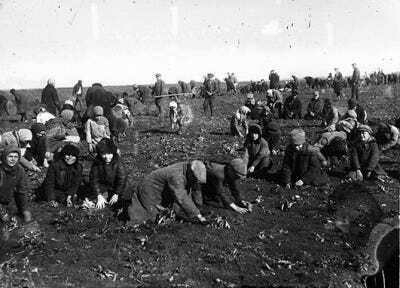
Children picking frozen potatoes on a collective farm field in the village of Udachne, Donetsk region, 1933. (Source: ЦДКФФА України імені Г. С. Пшеничного). Ukraine harvests approximately 18 tons of potatoes annually, with only two percent of these being produced by commercial and private enterprises. One-third of it is stored in the cellars of Ukrainians, and often goes uneaten for years.
During the winter months of the Holodomor, children would gather potatoes, both frozen and rotten, that were left over from the harvest, and their families would cook surrogate food – food substitutes made from non-traditional or inedible ingredients – with them. For example, traditional pancakes were made of potato starch or peels.
“I remember this old tradition of my grandmother and her two brothers, when other people would come – I was just amazed at how much food they cooked,” Oles said. “There were mostly borscht, sometimes soup, always two meat dishes, salads, and at least two cakes.”
At a certain point, amid the food shortages, Ukrainians began to prioritize the nutritional value of each meal. In 1939, the book ‘On Tasty and Healthy Food’ was published. The purpose was to educate people about the nutritional value of products, its calorie content, and cost.
As a result, Soviet dishes, such as Olivier and crab salad, began to gain popularity. The salads contained boiled eggs, potatoes, vegetables, rice, mayonnaise, and sausages — cheaper and of lower quality than meat.
Even 90 years later, some descendants of Holodomor survivors are developing eating disorders amid the fears and misconceptions imposed on them.
Other Ukrainians with ancestors who survived the famine have a higher risk of developing type 2 diabetes. Examining more than 10 million Ukrainians born in the 1930s, a scientific study found that exposure to famine during early childhood more than doubled the chances for developing type 2 diabetes in later life.
To this day, some people still struggle to discuss the famine.
“I know that in many families they did not want to or did not like to remember these events,” Oles said. “My mother did not like it either. But my grandmother did not hide it.”
It takes a great deal of self-reflection to see how context becomes character.
But for every preserved jar still sitting in dark Ukrainian cellars, for every piece of stale bread carefully repurposed for later, is a story of survival.
NEWS OF THE DAY:
Good morning to readers; Kyiv remains in Ukrainian hands.
U.S. MAY SEND UKRAINIANS TO GITMO: This week, the U.S. may begin relocating thousands of foreigners who are staying in the country illegally, The Washington Post reported.
They will likely be sent to the U.S. military base in Guantanamo, Cuba. Among them are citizens of allied countries such as Ukraine, the U.K., Italy, France, Germany and Belgium
The Trump administration is unlikely to inform the allied governments before this sort of forced relocation. Guantanamo Bay is known as a prison for terrorism suspects and others captured after the events of 9/11. In January, Trump stated that he would move up to 30,000 migrants there.
‘OPERATION SPIDER WEB’ CARRIED OUT WITH UNIQUE DRONES: SBU engineers developed unique drones specifically for ‘Operation Spiderweb,’ Babel reported. Operators could remotely control the drones in real time from thousands of kilometers away from Ukraine’s state border, as well as bypass Russian air defense systems.
According to SBU claims, these drones were able to strike approximately 34% of Russia’s strategic aviation, thereby weakening Russia’s capacity to deliver massive strikes on Ukrainian cities.
RUSSIAN SPY DETAINED IN POLAND: A Polish citizen has been arrested on suspicion of spying for Russia, the Polish prosecutor’s office reported.
He had been transmitting information to Russian intelligence services from February 2024 to April 2025. This included data on infrastructure critical to Poland’s defense. The disclosure of this information allegedly posed a serious threat to the country’s national security.
This is not the first time Russian spies have been exposed in Poland. They have reportedly been carrying out sabotage attacks on Polish territory, directed by Minsk and Moscow.
DRAKONCHIK OF WAR:
Today we have a drakonchik of war (a diminutive of ‘dragon’ in Ukrainian) from our reader Anna Bowles!
Whenever she comes to Ukraine, he sits on the windowsill, ready to spit fire at any drones or missiles that might dare to approach the building.
Stay safe out there.
Best,
Tim -
Russia’s nuclear deterrent against US not 'significantly' affected by Ukraine’s Operation Spiderweb, official claims
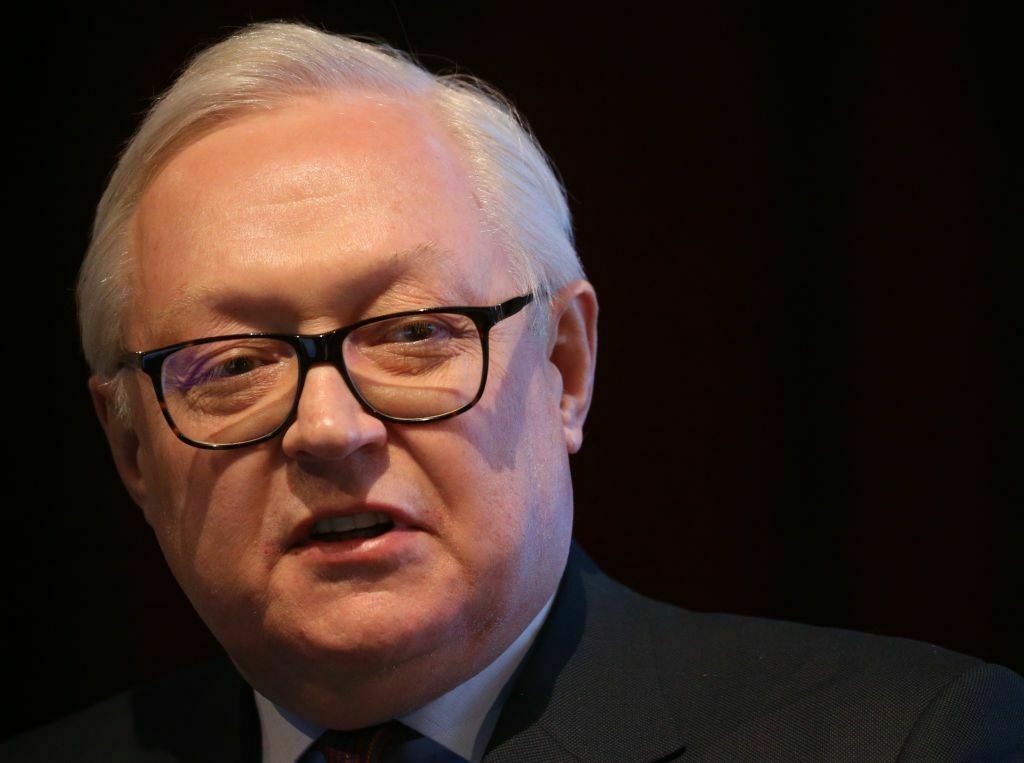
Russia’s nuclear deterrence capabilities have not been significantly impacted in recent Ukrainian drone strikes on several military airfields, Russia’s Deputy Foreign Minister Sergei Ryabkov said on June 11.
His comments come days after Ukraine launched a coordinated drone attack, dubbed Operation Spiderweb, targeting at least four major Russian air bases and reportedly damaging dozens of aircraft, including strategic bombers and airborne early warning planes.
Ryabkov claimed that the extent of the damage from the attacks has been “greatly exaggerated” and that none of Russia’s strategic forces were weakened.
“Our nuclear deterrence potential against the U.S. and any other potential adversary has not suffered significant damage,” Ryabkov said, according to the state-run news agency RIA Novosti.
Russia has repeatedly issued nuclear threats against Ukraine and Western countries since launching its full-scale invasion in February 2022. Those threats have so far not materialized, as Russia continues to wage its war.
The Spiderweb attack was planned over 18 months and carried out by the Security Service of Ukraine (SBU), and is believed to have disabled or destroyed a significant portion of Russia’s long-range bomber fleet.
Ukraine claims the operation damaged 41 aircraft and disabled up to 34% of Russia’s strategic bombers. Independent satellite imagery has confirmed destruction or damage at several sites, including multiple Tu-95MS and Tu-22M3 bombers at the Belaya air base.
President Volodymyr Zelensky said on June 4 that nearly half of the planes hit in the attack are impossible to repair. NATO estimates that between 10 and 13 Russian planes were completely destroyed, and more were damaged.
Ryabkov previously acknowledged damage to Russian aircraft but claimed that all of them could be put back into service.
Ukraine’s SBU releases fresh video of Operation Spiderweb, teases ‘new surprises’“The SBU is hitting and will hit (Russia) where it considers itself unreachable!” SBU chief Vasyl Maliuk said. “We are working on new surprises, no less painful than the Operation Spiderweb.”The Kyiv IndependentMartin Fornusek
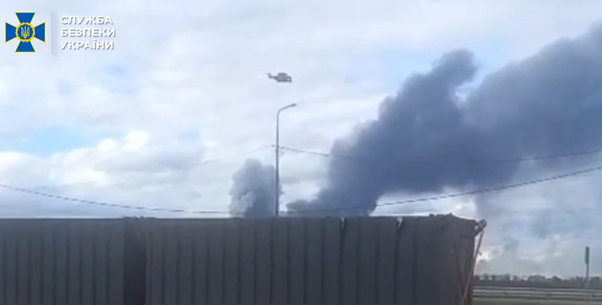
-
Russia sentences top Navalny ally Volkov to 18 years in prison in absentia
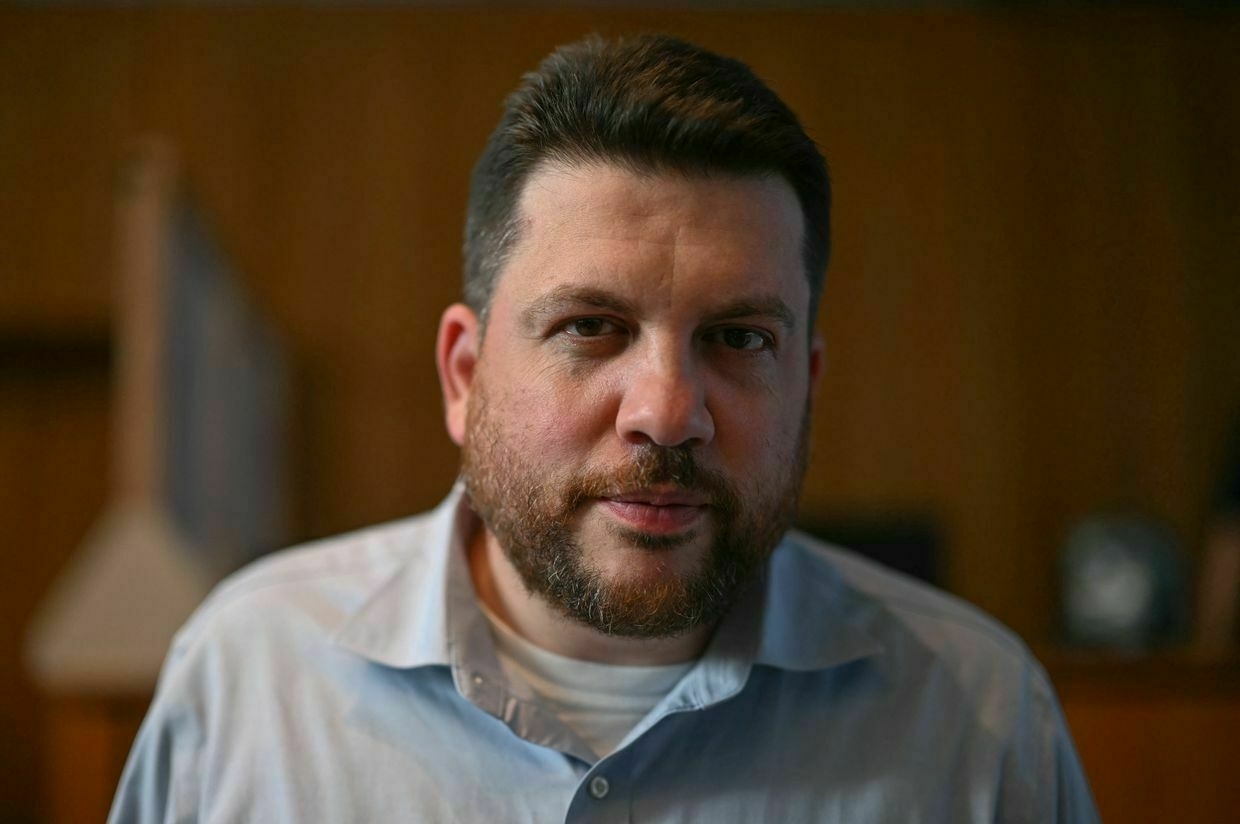
A Moscow military court sentenced Leonid Volkov, a Russian oppositionist and associate of late Alexei Navalny, to 18 years in maximum security prison, Mediazona reported on June 11.
The ruling was issued in absentia as Volkov was forced to leave Russia in 2019 and was placed on the federal wanted list in 2021. He currently resides in Lithuania.
The judge sentenced Volkov to a maximum sentence demanded by the prosecution based on 45 cases under nine criminal articles.
The accusations raised against the oppositionist ranged from “discrediting” the Russian military, ties to an allegedly “extremist group,” and the “rehabilitation of Nazism” to involving underage persons in rallies and vandalism.
The said charges are often used by the Kremlin to suppress political dissent and silence opposition voices.
Volkov was also ordered to pay a fine of 2 million rubles ($25,000) and banned from engaging in any online activity.
Volkov was one of the closest allies of Navalny, who died in a Russian prison in February 2024 under unclear circumstances. Volkov was Navalny’s chief of staff during the latter’s 2018 presidential bid and led his Anti-Corruption Foundation (FBK) organization until 2023.
In the summer of 2022, Volkov was charged in Russia for “justifying terrorism” and with “discrediting” the military, a charge invented by Russian authorities to silence criticism of the war against Ukraine.
Volkov suffered injuries when he was assaulted at his home in Lithuania in March 2024. A month later, Polish authorities detained a Belarusian suspected of organizing the attack on Moscow’s behalf.
The Russian regime has intensified its crackdown on the domestic opposition since the outbreak of Moscow’s all-out war against Ukraine in 2022.
-
Ukraine grants Poland permission to exhume 1939 war graves in Lviv
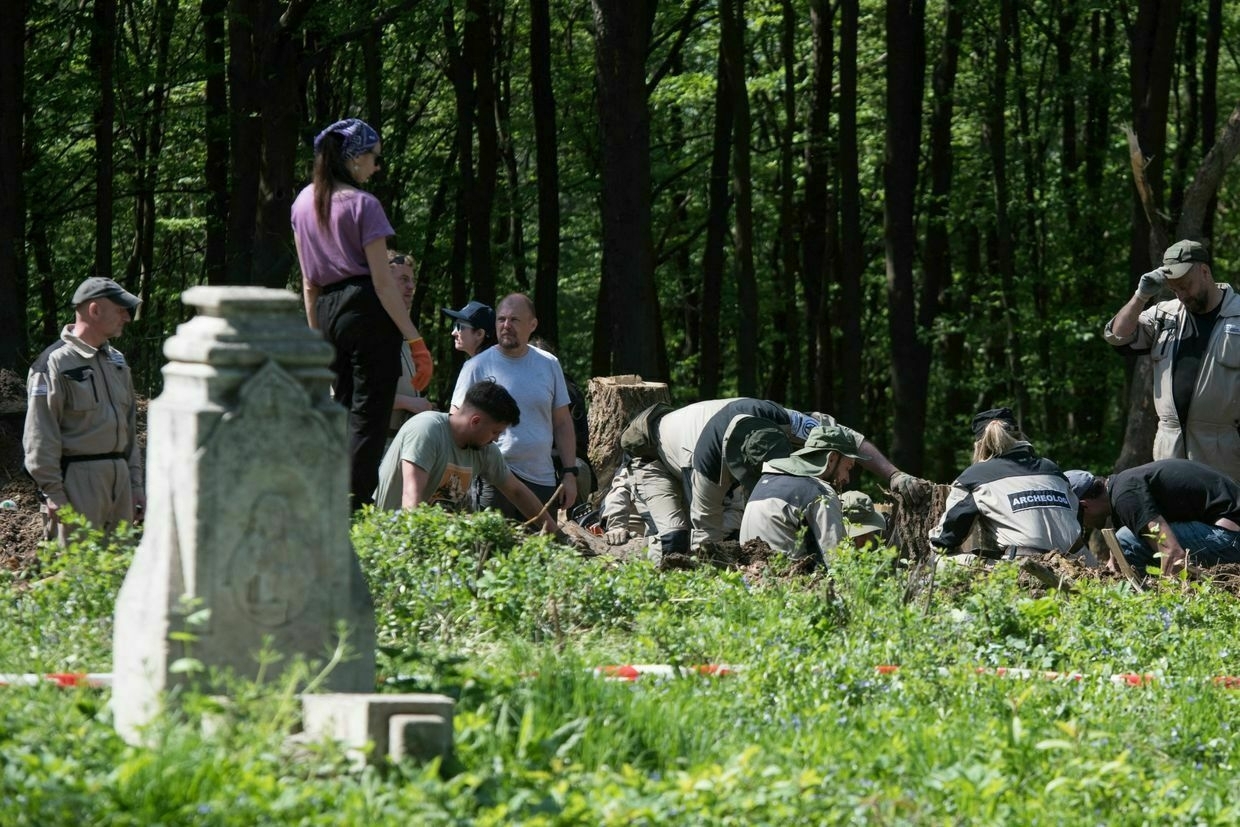
Ukraine has granted Poland permission to carry out exhumation work on the remains of Polish soldiers killed in 1939 and buried in the area of the former village of Zboiska, now part of the western city of Lviv, Ukraine’s Culture Ministry announced on June 11.
The renewed cooperation follows years of tension surrounding the treatment of war memorials and historical sites.
Ukraine imposed a moratorium on exhumations in 2017 after several Ukrainian Insurgent Army (UPA) monuments were destroyed in Poland. The moratorium effectively ended last April when Ukrainian and Polish researchers carried out joint exhumations of the Volyn massacre victims in Ukraine’s Ternopil Oblast.
The Culture Ministry said the latest decision is a further step in Polish-Ukrainian cooperation on sensitive historical issues and follows the work of the Joint Polish-Ukrainian Working Group on historical matters.
“Ukraine confirms its readiness to continue search and exhumation work within the framework of the Joint Working Group,” the ministry said in a statement. It added that the exhumations at Zboiska represent a continuation of efforts to address historical memory and reconciliation.
The Zboiska site is believed to contain the remains of around 120 Polish soldiers who died fighting against Nazi German forces in 1939, Rzeczpospolita reported. The remains were first located in 2019, according to Polish officials. The Institute of National Remembrance of Poland (IPN) had submitted a formal request to excavate burial grounds in Zboiska and the nearby district of Pid Holoskom.
The ministry also lauded the April exhumations in the former village of Puzhnyky in Ternopil Oblast as the first successful step of this new cooperation.
Puzhnyky is associated with the 1945 killing of Polish civilians by the UPA during the Volyn massacres, one of the most painful and contentious chapters in Polish-Ukrainian history.
In a reciprocal gesture, Ukraine has received Poland’s approval to carry out its own search and exhumation activities in the Polish village of Yurechkova. Kyiv says it hopes such work can begin soon.
The Culture Ministry emphasized that the progress reflects the constructive relationship between the two countries and their shared commitment to historical truth and dignity for the dead.
“Joint remembrance and steps toward one another will unite our nations in the name of our shared European future,” the statement said.
In January, Polish Prime Minister Donald Tusk called the agreement on exhumation efforts a “breakthrough,” while officials in Warsaw warned that unresolved historical issues could influence Ukraine’s aspirations to join the European Union and NATO.
Volhynian Massacre — the Achilles heel of Ukrainian-Polish relationsSpeaking on Polish television in late July, Poland’s Defense Minister Wladyslaw Kosiniak-Kamysz reminded Ukrainians that even his country’s overwhelming support for Ukraine in its fight against Russia has its limits. Ukraine could never expect Poland’s backing in joining the EU if it didn’t “resolve” the historicalThe Kyiv IndependentDaria Svitlyk
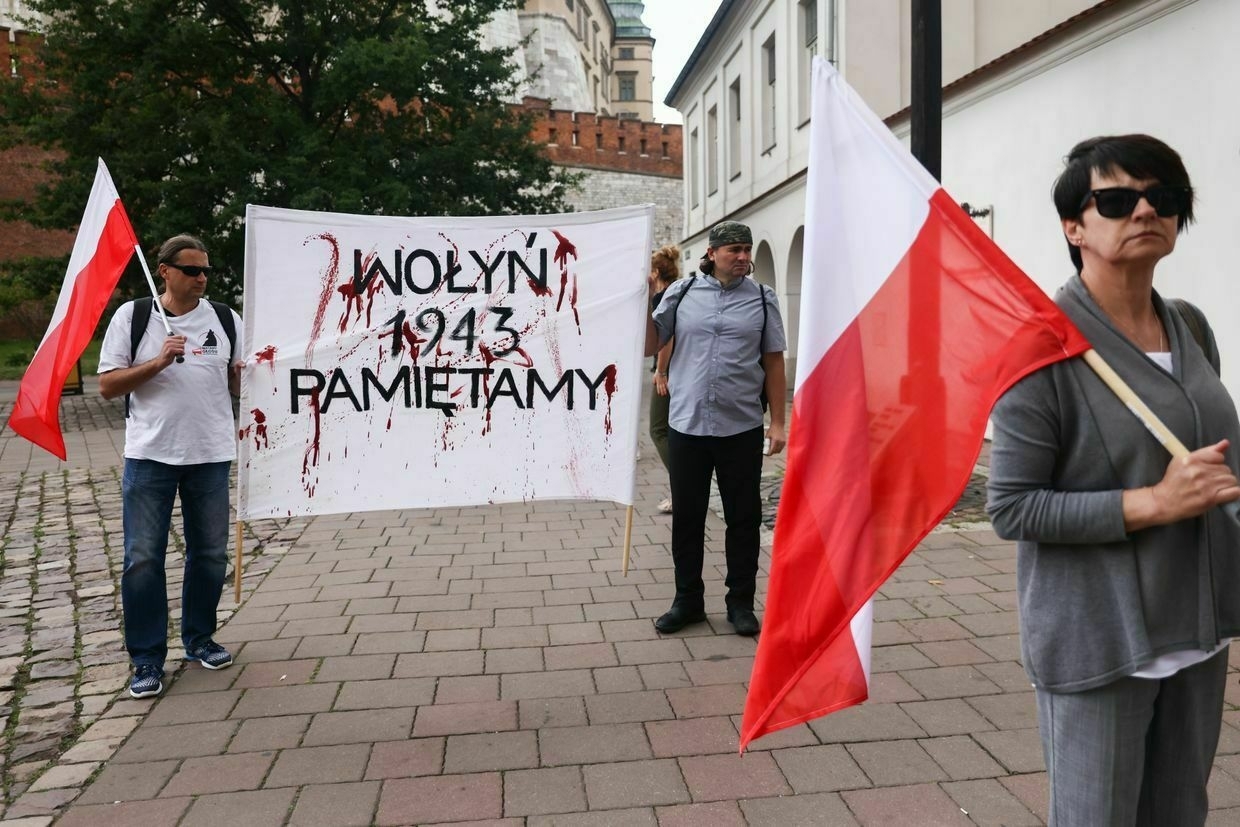
-
Ukrainian drone strike sparks major fire at Russia's largest gunpowder plant in Kotovsk
In the early hours of June 11, a drone attack targeted the Tambov Gunpowder Plant in Kotovsk, as reported by the Telegram channel "News of Tambov and the Region". The attack led to a significant fire, accompanied by the sound of sirens throughout the city. Residents spotted the UAV soaring above Kotovsk, evading local air defenses, before striking the gunpowder facility, resulting in an intense blaze.
Footage captured the moment of an explosion, allegedly on the factory grounds. The Russian state agency TASS reported that a "massive UAV attack on Kotovsk" was repelled during the night.
The interim governor of the Tambov region, Yevgeny Pervyshov, confirmed the drone attack on Kotovsk . He said that a large-scale UAV attack by the Ukrainian regime was countered, although he withheld specifics on the exact target. Pervyshov noted that one downed drone's crash led to a fire quickly extinguished by fire services, with no casualties reported.
According to the Russian Ministry of Defense, 32 Ukrainian drones were "intercepted and destroyed" last night. The interceptions took place as follows: half over the Voronezh region, eight over the Kursk region, five over the Tambov region, two over the Rostov region, and one near the coast of annexed Crimea.
In response to the Ukrainian attack, temporary flight restrictions were imposed on the receiving and departing aircraft at the airports in Kaluga and Saratov. Restrictions were lifted at the Saratov airport at 5:15 AM.
This marks the latest in a series of drone strikes on the Kotovsk plant, with a recent attack on May 29 setting a warehouse roof ablaze and leading to worker evacuations Previously, the site was targeted in January, as well as in 2024 and 2023, with the earlier blast resulting in four fatalities. The Kotovsk plant is Russia's largest producer of gunpowder for firearms and artillery shells.
-
NATO summit statement omits Ukraine's entry bid, $40 billion pledge, Bloomberg reports
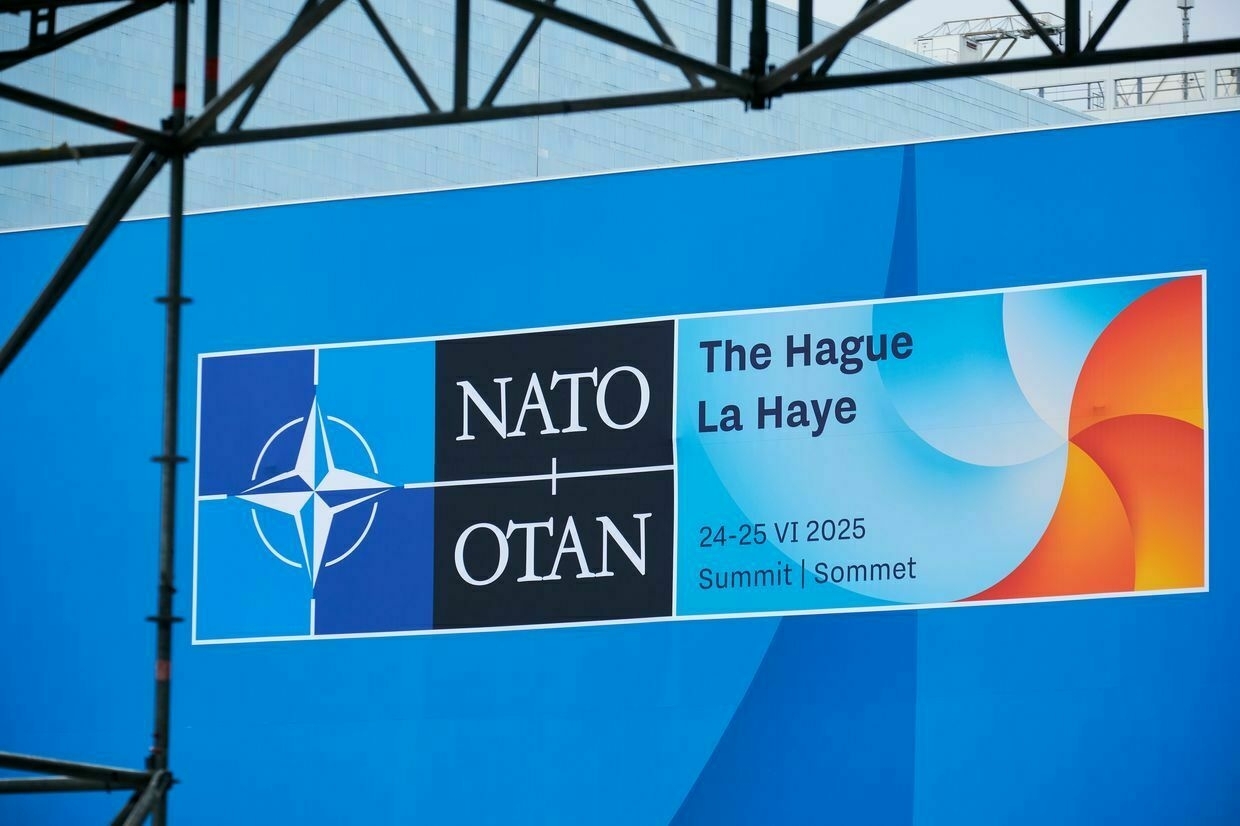
A one-page draft of a joint declaration for the upcoming NATO summit omits Ukraine’s membership aspirations and last year’s pledge of over $40 billion in support, Bloomberg reported on June 11 after reviewing the draft.
This news signals that, for the first time since 2022, Russia’s war against Ukraine will not be the chief focus of the annual NATO meeting, which is taking place on June 24-25 in The Hague.
The unusually brief document recognizes Russia as a threat to NATO but not as an aggressor in Ukraine. It also does not mention China, Bloomberg reported.
The communique of the 2024 summit in Washington named Beijing as a “decisive enabler” of Russia’s war against Ukraine. Last year’s gathering also included a declaration that Ukraine’s path to NATO is “irreversible” and promised more than $40 billion in additional military aid.
This year, the document will solely focus on defense spending, as U.S. President Donald Trump pushes NATO partners to hike the military expenditure benchmark from 2% to 5% of GDP.
The final version of the statement can still change, Bloomberg reported.
The brevity of the communique and the summit itself, as well as the decreased focus on Ukraine, stems from the effort to avoid conflict between Trump and European allies.
In a sharp break from former U.S. President Joe Biden, the Trump administration has not approved any new military aid packages to Ukraine and signaled its intent to reduce assistance for Kyiv in the next year’s budget.
The U.S. president initially vowed to broker a peace deal between Kyiv and Moscow but became increasingly less engaged in the process as the negotiations stalled and Russia only intensified its attacks against Ukraine.
According to Bloomberg, NATO allies will pledge to allocate at least 3.5% of GDP to defense needs and 1.5% to protecting infrastructure and civil preparedness by 2032. Member states will also consider counting their contributions to Ukraine as part of the new defense spending targets, the news outlet reported.
The summit was preceded by rumors that President Volodymyr Zelensky would not be invited to participate for the first time due to U.S. opposition.
Later, the speculations were dispelled after the Dutch media reported that NATO Secretary General Mark Rutte had invited the Ukrainian leader to attend.
As Russia inches closer to Dnipropetrovsk Oblast, new Ukrainian region might soon be at warMoscow said its troops had crossed into Dnipropetrovsk Oblast and were conducting offensive operations in the region, a claim Kyiv quickly denied as “Russian disinformation.” Russian troops have been pushing toward Dnipropetrovsk Oblast for months, trying to solidify the southern flank to capture Pokrovsk and the remaining parts of theThe Kyiv IndependentAsami Terajima
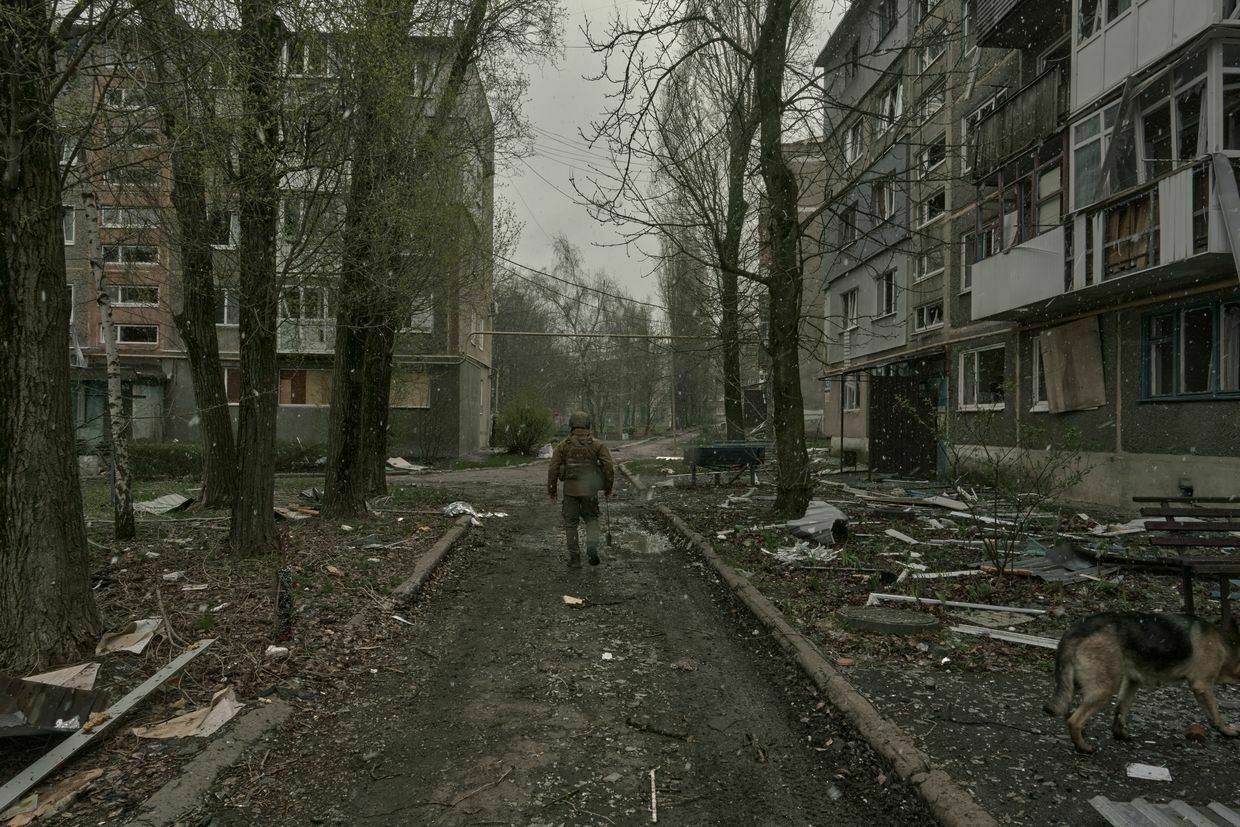
-
Kyiv, not Kiev — Kyiv Independent community helps rename street in Oregon
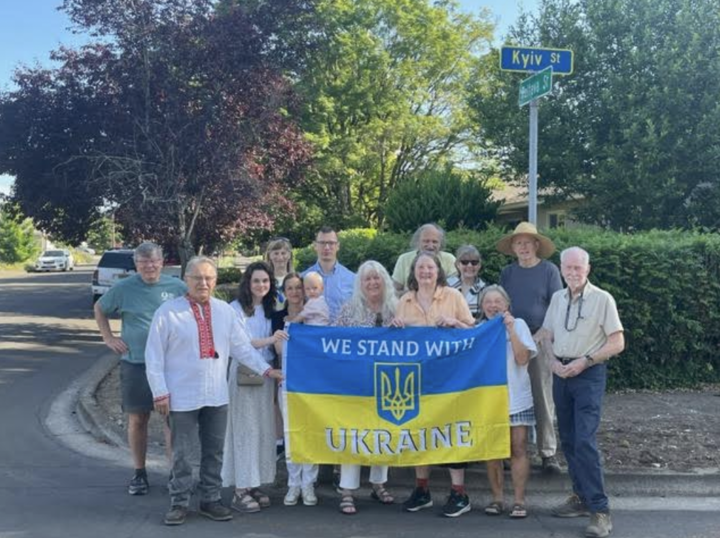
A neighborhood in Springfield, Oregon, on June 10 renamed a local street from “Kiev” to “Kyiv” — a move initiated by members of the Kyiv Independent’s global community.
Photos shared with the Kyiv Independent show the newly installed blue-and-yellow street sign, reflecting both the correct Ukrainian transliteration and the national colors of Ukraine.
The change comes amid a broader effort by Ukraine and its allies worldwide to move away from Russian-derived place names and honor Ukraine’s linguistic and political independence.
“We’re very proud of our city (Springfield, OR, U.S.) for supporting our efforts to make this happen,” one community member told the Kyiv Independent.
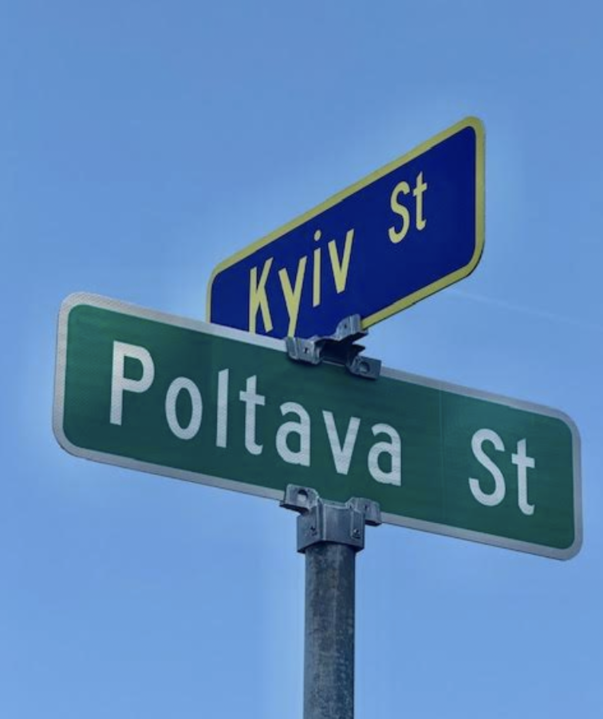
The new street sign in a neighborhood of Springfield, Oregon, U.S. (Photo provided by Kyiv Independent community members) The spelling “Kiev,” pronounced “kee-yev,” is the Russian version of Ukraine’s capital. “Kyiv” (pronounced “keev”) is the correct Ukrainian form, based on the native pronunciation and Latin transliteration.
For decades, global usage favored Russian-based spellings, a legacy of the Soviet Union’s dominance and the widespread misconception that Ukrainian cities and culture were merely extensions of Russia. Even after Ukraine declared independence in 1991, much of the international community continued using names like Kiev, Lvov, and Odessa — all Russified versions.
That began to change after Russia’s 2014 annexation of Crimea and its war in eastern Ukraine. The full-scale invasion in 2022 accelerated the shift, prompting governments, media outlets, and advocacy groups to adopt Ukrainian transliterations such as Kyiv, Lviv, and Odesa.

A city worker installs a new street sign in Springfield, Oregon, U.S., officially changing the spelling from “Kiev” to “Kyiv.” (Photo provided by Kyiv Independent community members) Ukraine’s Foreign Ministry has promoted the change through campaigns like #KyivNotKiev, arguing that the use of correct names respects Ukraine’s sovereignty and resists Russian imperial narratives.
Russian leaders, including President Vladimir Putin, have long emphasized historical ties to Kyiv in their justification for expansionist policies. Renaming streets and using correct spellings is one way communities abroad are pushing back.
Kyiv, not Kiev — How Ukrainians reclaimed their capital’s nameEnglish speakers the world over long referred to Ukraine’s capital as Kiev, not realizing they were using the Russian name for the city.The Kyiv IndependentAnna Belokur

-
Poland detains citizen suspected of spying for Russia
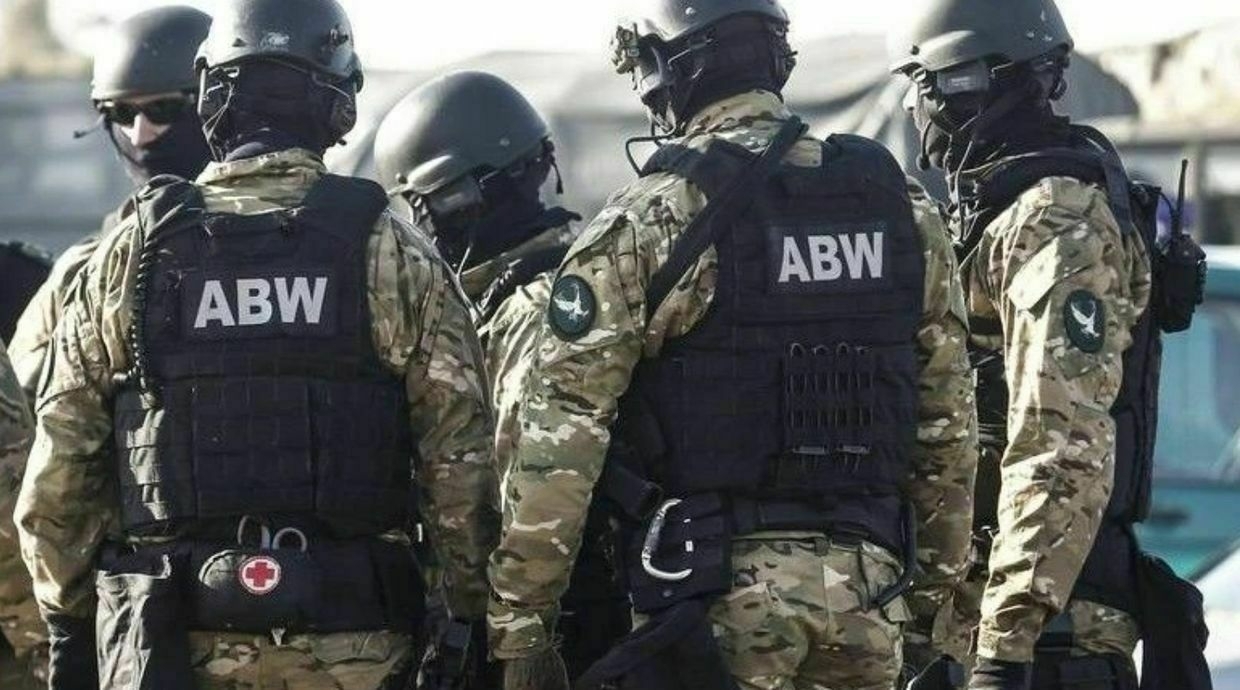
A Polish citizen has been arrested on suspicion of spying for Russia, the Polish Prosecutor’s Office announced on June 11.
According to prosecutors, 28-year-old Wiktor Z. was detained on June 4 by Poland’s Internal Security Agency (ABW) on charges of gathering and passing sensitive information to Russia’s intelligence services. The arrest followed searches of several properties in the Kuyavian-Pomeranian region in northern Poland, authorities said.
Warsaw has intensified its crackdown on Russian intelligence activity following a number of sabotage attacks allegedly directed by Moscow. Several suspected spy networks, allegedly run by Minsk and Moscow, have been uncovered in Poland over the past years.
Prosecutors said Wiktor Z. is suspected of offering to cooperate with Russian intelligence and engaging in espionage between February 2024 and April 2025 in the city of Bydgoszcz and abroad. He allegedly collected data about infrastructure critical to Poland’s defense, the disclosure of which could pose a serious threat to national security.
The suspect acted “out of ideological and pro-Russian convictions,” the Prosecutor’s Office said in a statement. Wiktor Z. has been placed in pretrial detention for three months. If convicted, he faces a minimum of eight years in prison or up to a life sentence.
In May, Polish Foreign Minister Radoslaw Sikorski announced the closure of the Russian consulate in Krakow after accusing Russian intelligence of orchestrating a 2024 arson attack that destroyed the Marywilska shopping center in Warsaw.
Polish officials, including Prime Minister Donald Tusk and Justice Minister Adam Bodnar, have blamed the Kremlin for directing the sabotage, citing detailed intelligence. Multiple individuals have been arrested in connection with the fire, which burned down a complex housing over 1,400 stores.
Authorities in Lithuania have also linked Russia’s intelligence services to similar sabotage incidents, including an arson attack on an IKEA warehouse in Vilnius, causing over half a million euros in damages. Polish and Lithuanian officials are reportedly cooperating on the investigations.
Russia has denied involvement and condemned Poland’s move to shut down its diplomatic post, warning of retaliation.
Western officials have warned of a growing Russian sabotage campaign across Europe targeting states that support Ukraine amid Moscow’s ongoing invasion.
From spy rings to arson — Russia’s sabotage across Europe continues unpunishedAlongside Russia launching its full-scale invasion of Ukraine, Moscow has also ramped up its hybrid attacks across Europe. In 2024 alone, Russia could be behind around 100 “suspicious incidents” in Europe, Czech Foreign Minister Jan Lipavsky claimed. Last month, the Dutch intelligence said that Moscow keeps stepping up its attacksThe Kyiv IndependentKateryna Denisova
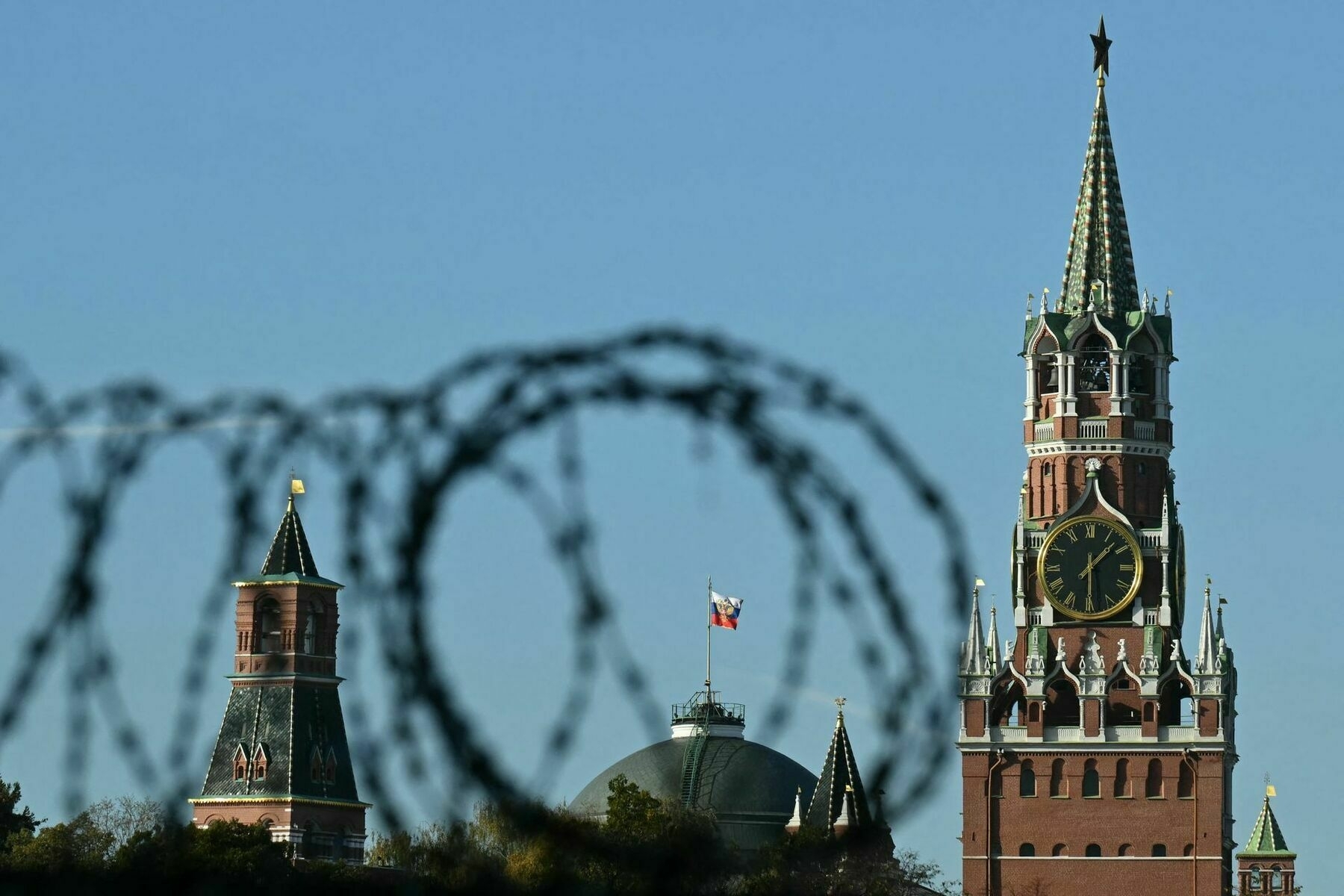
-
Ukraine repatriates bodies of 1,212 fallen soldiers
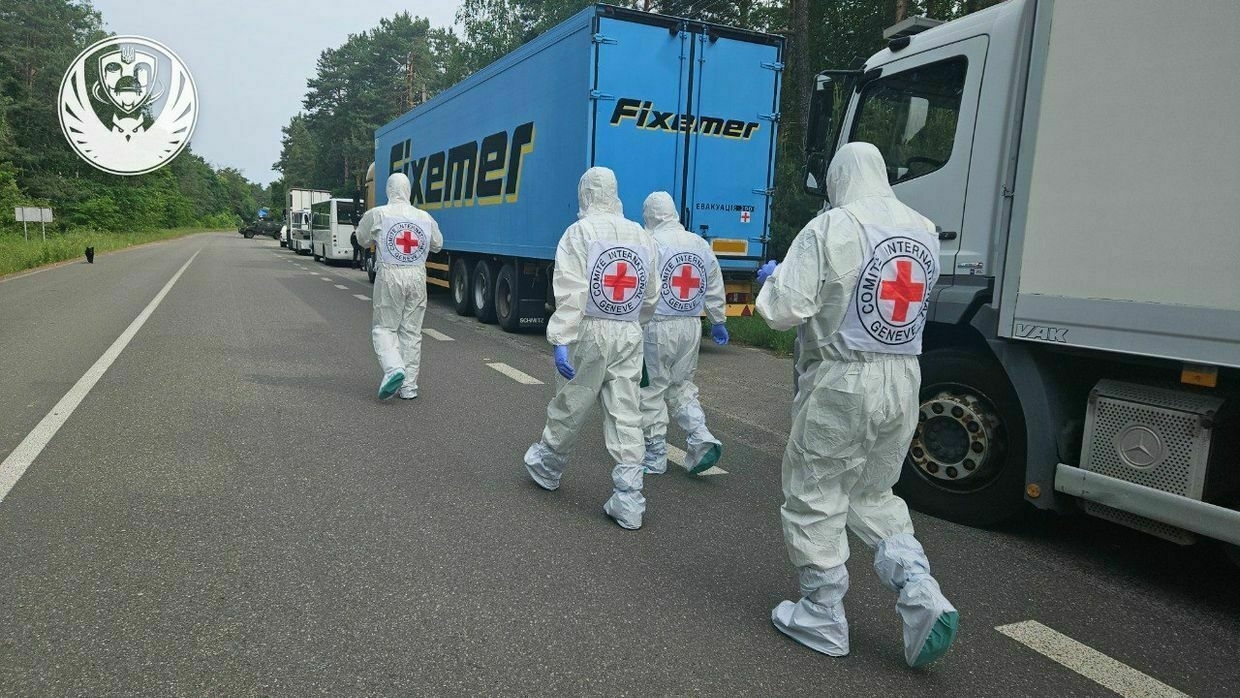
Ukraine has brought back the bodies of 1,212 fallen service members, the Ukrainian Coordination Headquarters for the Treatment of Prisoners of War (POW) said on June 11.The announcement follows Russian-Ukrainian Istanbul talks on June 2, which focused on exchanges of POWs and fallen soldiers.
The repatriation was carried out through a coordinated effort involving Ukraine’s Security Service, the Armed Forces, the Interior Ministry, the Ombudsman’s Office, the State Emergency Service, and other national security and defense institutions. The International Committee of the Red Cross also supported the operation.
The remains of soldiers were returned from multiple front-line regions, including Kharkiv, Donetsk, Luhansk, Zaporizhzhia, Kherson, and Sumy oblasts.
Officials emphasized that investigative and forensic teams from the Interior Ministry and the Health Ministry are working to identify the bodies in the shortest possible time.
At the Istanbul meeting on June 2, Russian and Ukrainian delegations agreed on a new exchange of POWs but failed to reach a ceasefire agreement.
The Turkey-hosted talks were the second round since mid-May and resulted in an agreement to exchange severely wounded and young prisoners, with President Volodymyr Zelensky saying up to 1,200 individuals could be returned on each side. Russia also pledged to transfer up to 6,000 bodies of Ukrainian soldiers.
Following the Istanbul talks, Ukraine and Russia have already conducted two prisoner exchanges on June 9 and 10. While exact figures were not immediately disclosed, Ukraine confirmed the return of severely wounded and chronically ill prisoners, including those captured during the 2022 siege of Mariupol and held for more than three years.
In Istanbul, Ukraine also submitted a peace proposal that called for a full ceasefire, an “all-for-all” POW exchange, the return of abducted children, and the use of frozen Russian assets to rebuild Ukraine. Russia has yet to formally respond.
Ukraine, Russia conduct second prisoner swap under Istanbul deal“All of them require immediate medical attention,” President Volodymyr Zelensky said.The Kyiv IndependentTim Zadorozhnyy
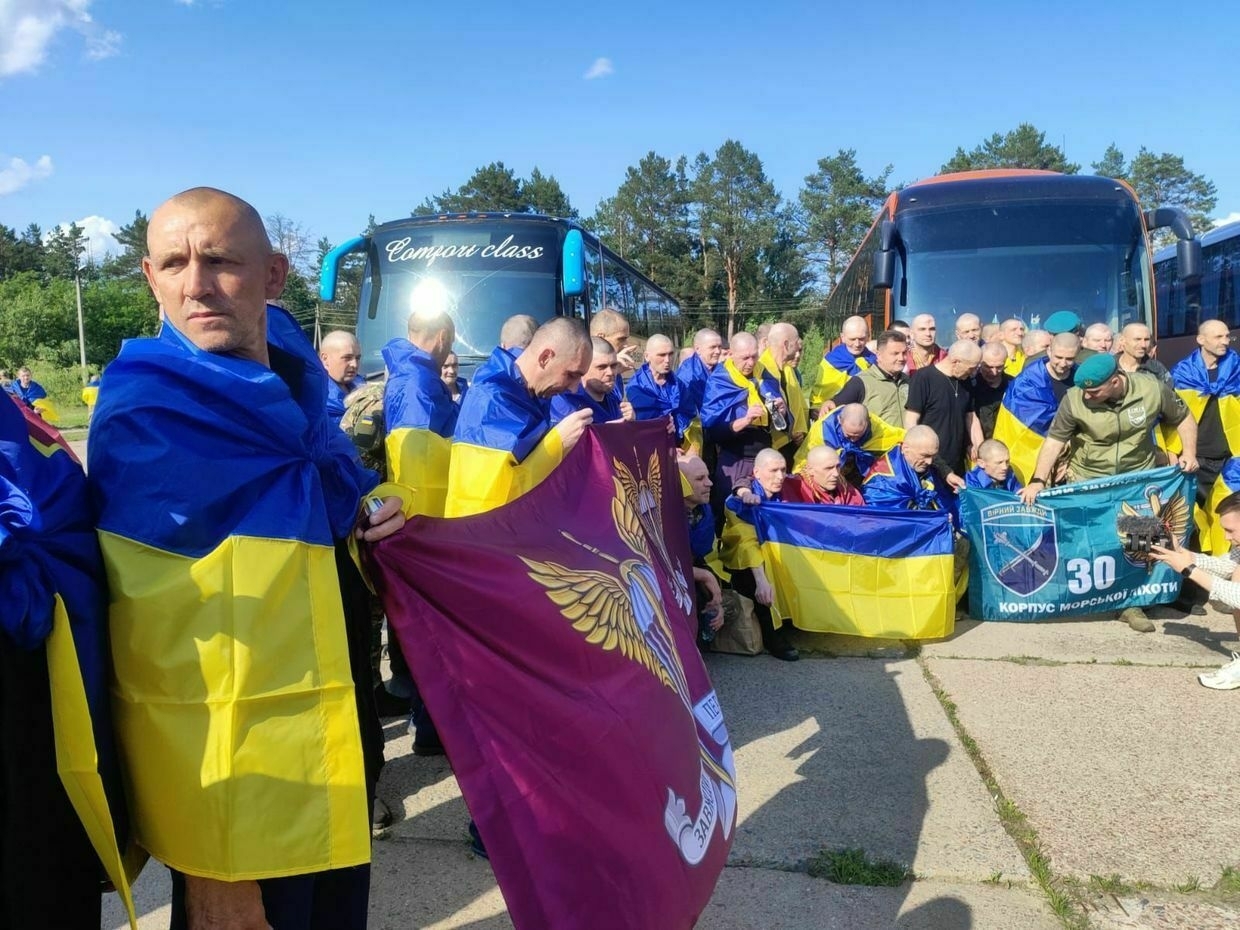
-
FAKE: After the Spiderweb operation, desertion cases in the AFU increased — ISW
Verification within Meta’s Third-Party Fact-Checking Program
A video allegedly created by the Institute for the Study of War (ISW) is being circulated online. It claims that after the Ukrainian Security Service’s Spiderweb operation, cases of desertion in the Armed Forces of Ukraine (AFU) increased. Expert Bill Kristol allegedly explained this phenomenon as an “emotional exhaustion point”, when aggressive actions against the enemy do not boost morale but have the opposite effect.
This is fake. ISW did not publish such a video; it does not match the style and format of the organization’s official materials. Bill Kristol’s quoted statement was fabricated.
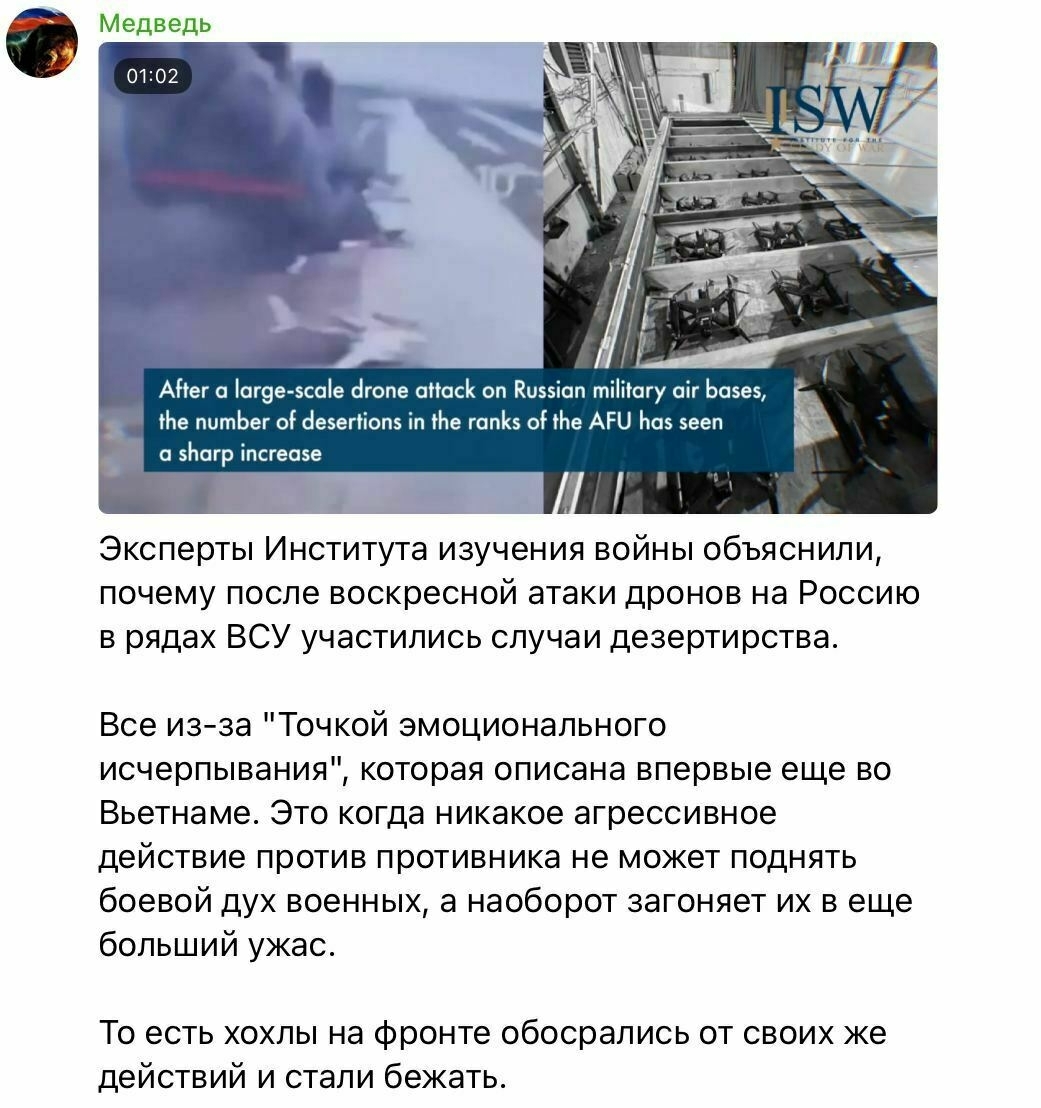
Screenshot of the post
On June 1, 2025, the Security Service of Ukraine (SSU) conducted the Spiderweb operation, using FPV drones to target strategic aviation at four Russian airfields. According to the SSU and the General Staff of the AFU, Russia’s losses amounted to 41 aircraft. Independent OSINT analysts have confirmed 22–23 destroyed aircraft so far.
We checked ISW’s website and social media and did not find such a video. Moreover, its design differs from genuine reports: ISW typically does not produce videos without speakers or voiceovers accompanying visuals. Also, in recent ISW videos, the analytical center’s logo is not placed in the top right corner.

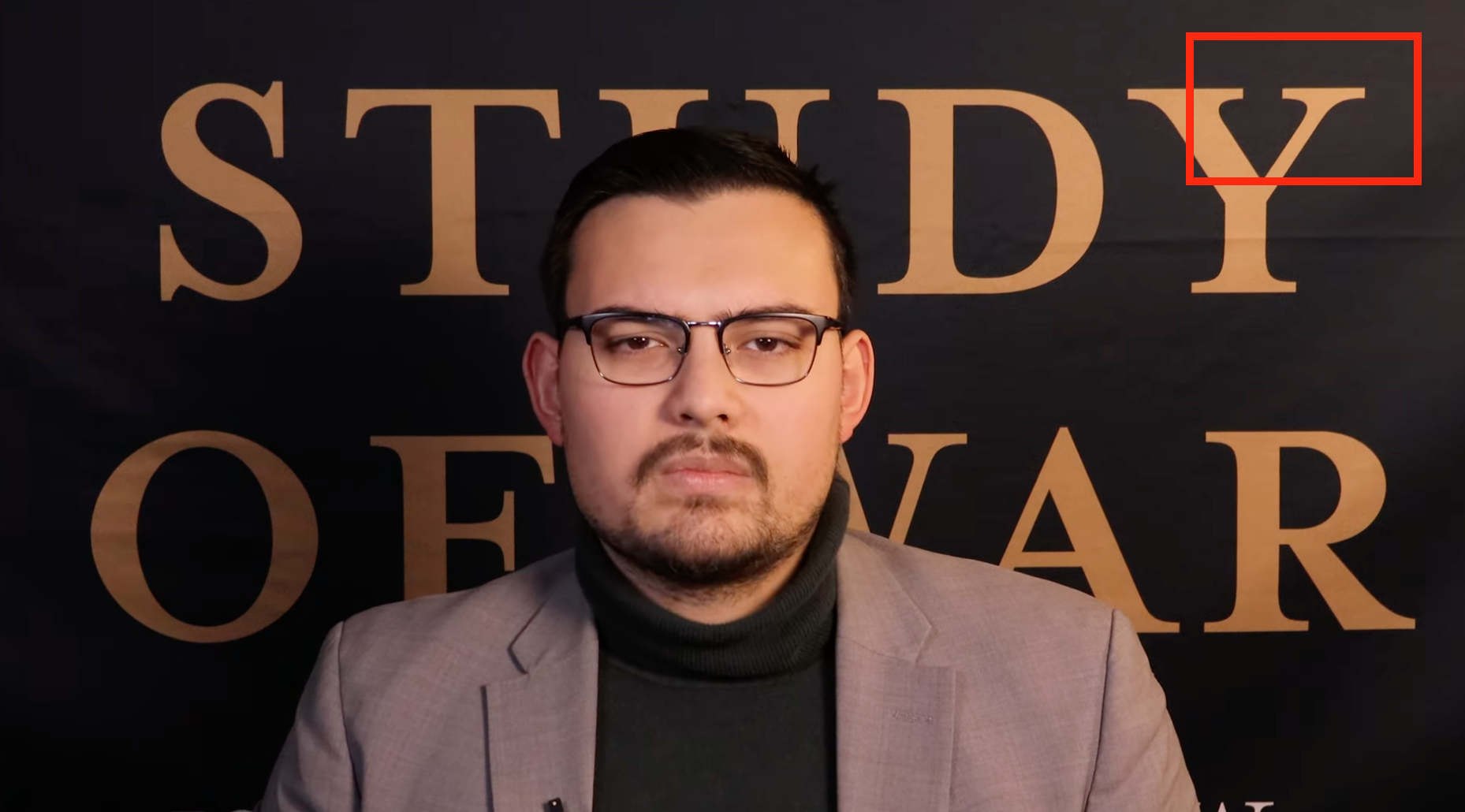
Furthermore, at the end of genuine ISW videos, a screen appears with the ISW logo without the center’s full name, the caption “Donate Today”, and a link to the website using uppercase and lowercase letters. The fake video, however, added the center’s full name to the logo, links to social media, decorative lines, and displayed the website address entirely in lowercase.


The video claims that the comment about increased desertion after the Spiderweb operation was given by “ISW expert” Bill Kristol. Kristol is a well-known political commentator and member of ISW’s board of directors, but he is not an ISW analyst.
On his social media page on X, he states that he is the director of Defending Democracy Together, co-editor of The Bulwark, and host of his interview project. Despite his daily activity on the page, his posts have no direct mentions of the Spiderweb operation. Instead, on June 1, the day of the operation, he posted a quote by Winston Churchill about Finland’s heroism, adding: “Brave Ukraine deserves a tribute like that Churchill paid to Finland in January, 1940…”
At the time of writing, the Office of the Prosecutor General website, where the number of opened criminal cases is usually published, including for “desertion” and “unauthorized abandonment of a military unit or place of service”, does not contain data for June. The most recent published information covers January to May 2025.
We have previously debunked multiple fakes distributed under the ISW logo, including claims that desertion in the AFU reached record levels in March 2025 or that the Kursk operation was the most disastrous in the past 200 years.
-
Serbia's president travels to Ukraine for his first-ever official visit
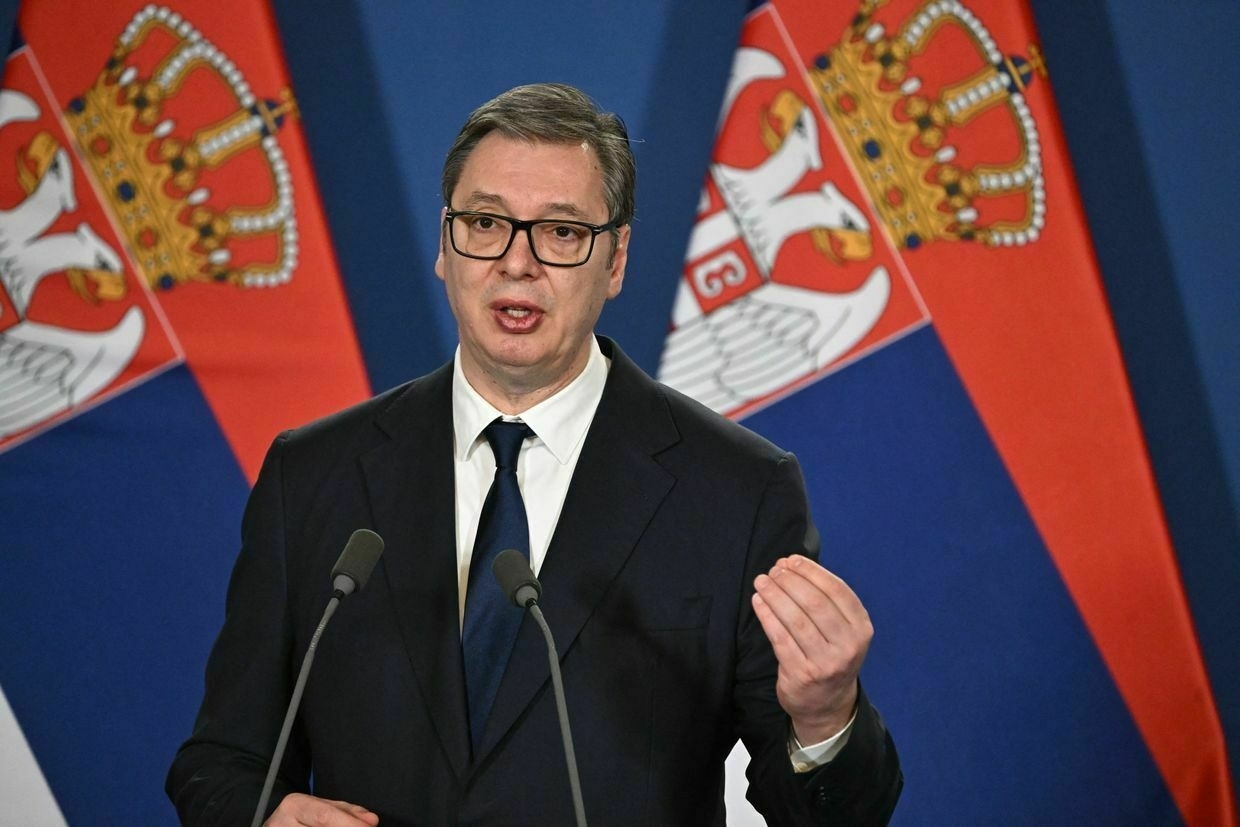
Editor’s note: The story is being updated.
Serbian President Aleksandar Vucic will visit Ukraine on June 11 to take part in the Ukraine-Southeast Europe Summit in Odesa, Serbia’s Presidential Office announced.
The one-day trip will mark the Moscow-friendly Serbian leader’s first official visit to Ukraine.
Top representatives of 12 southeastern European countries are expected to attend the meeting at the Ukrainian Black Sea coast city.
Belgrade has positioned itself as neutral in the Russia-Ukraine war, striving to balance its position as an EU candidate with its long-standing relationship with Moscow.
Vucic, Serbia’s populist president since 2017, was one of the few European leaders who attended the Moscow Victory Day celebrations on May 9, drawing rebuke from the EU.
The traditionally warm Russian-Serbian ties were strained recently after Russia’s intelligence accused Serbian defense companies of supplying arms to Ukraine via intermediaries. Vucic has denied the accusations.
‘We only work for Serbia’ — Vucic denies Moscow’s claims of Serbian companies supplying ammunition to Ukraine“We have formed a working group, together with Russian partners, to establish the facts… we work only for Serbia,” Serbian President Aleksandar Vucic said.The Kyiv IndependentMartin Fornusek
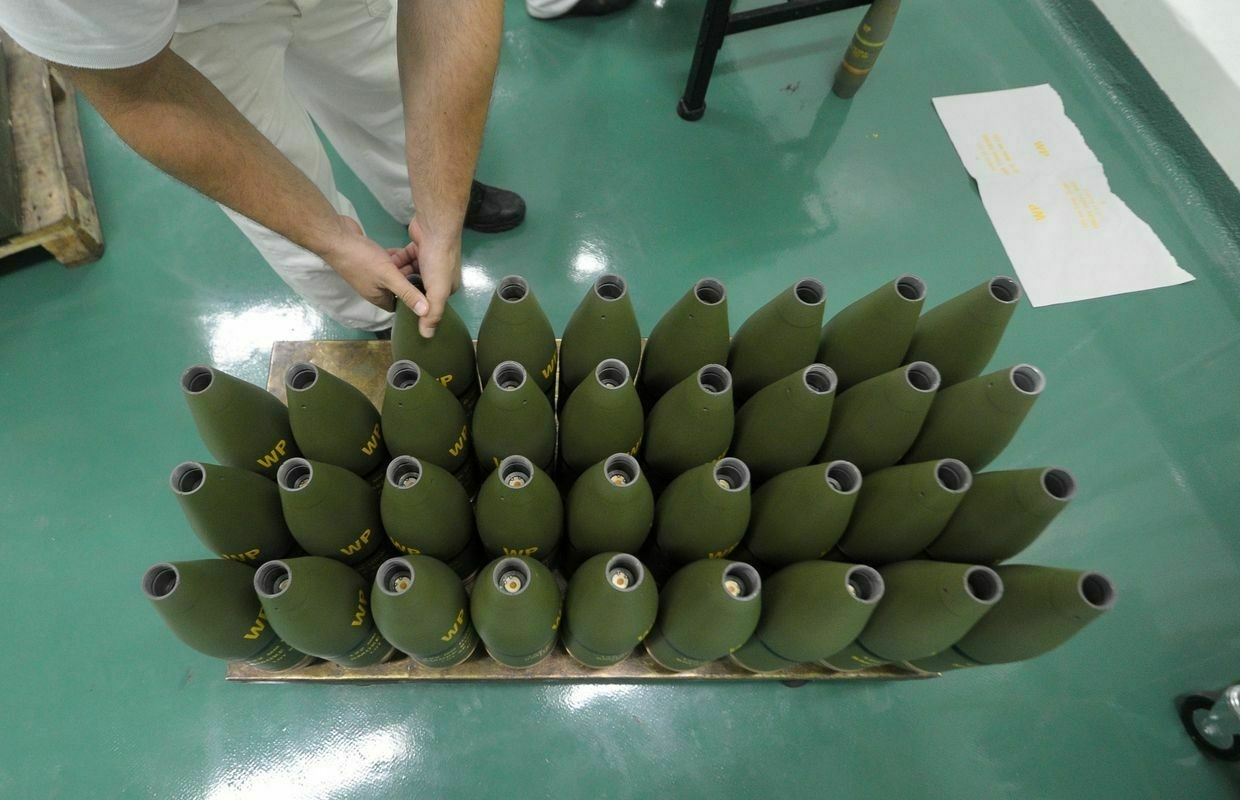
-
Ukraine's SBU releases fresh video of Operation Spiderweb, teases 'new surprises'
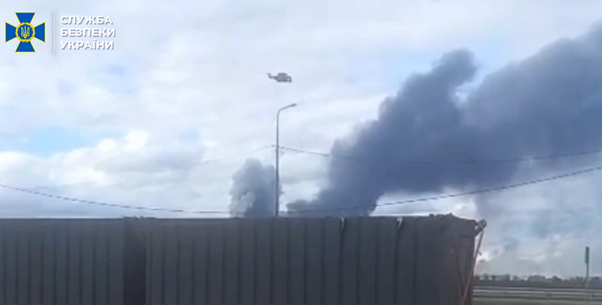
The Security Service of Ukraine (SBU) released on June 11 a new video detailing the sequence of its mass drone strike against Russia’s strategic aviation earlier this month.
The Operation Spiderweb, carried out on June 1, involved 117 drones that were hidden in trucks across Russia and deployed against four air bases, some thousands of kilometers from the Ukrainian border.
The operation damaged 41 aircraft, including Tu-95, Tu-22M3, and Tu-160 bombers, rare A-50 spy planes, and An-12 and Il-78 transport aircraft, causing damage of over $7 billion, the SBU said.
Trucks, seen in the footage driving in an undisclosed location, first transported first-person-view (FPV) drones and then wooden cabins to Russia, the SBU said. Already on Russian territory, the vehicles were loaded with cabins, which, in turn, carried the drones.
The preparations were taking place in the Russian city of Chelyabinsk, not far from a Federal Security Service (FSB) office, according to the SBU.
0:00/A video detailing Ukraine’s Operation Spiderweb on June 1, 2025. (SBU) The loaded trucks then drove to multiple locations in the cities of Ivanovo, Ryazan, and in the Murmansk, Irkutsk, and Amur oblasts. The cabins opened remotely at the time of the attack, allowing the drones to strike Russian planes at the Belaya, Olenya, Dyagilevo, and Ivanovo air bases.
The operation was also meant to strike at the Russian air base in Ukrainka in Amur Oblast, but this part of the attack failed.
SBU chief Vasyl Maliuk, who personally oversaw the operation, stressed that Ukrainian drones targeted “absolutely legitimate targets – military airfields and aircraft that attack our peaceful cities."
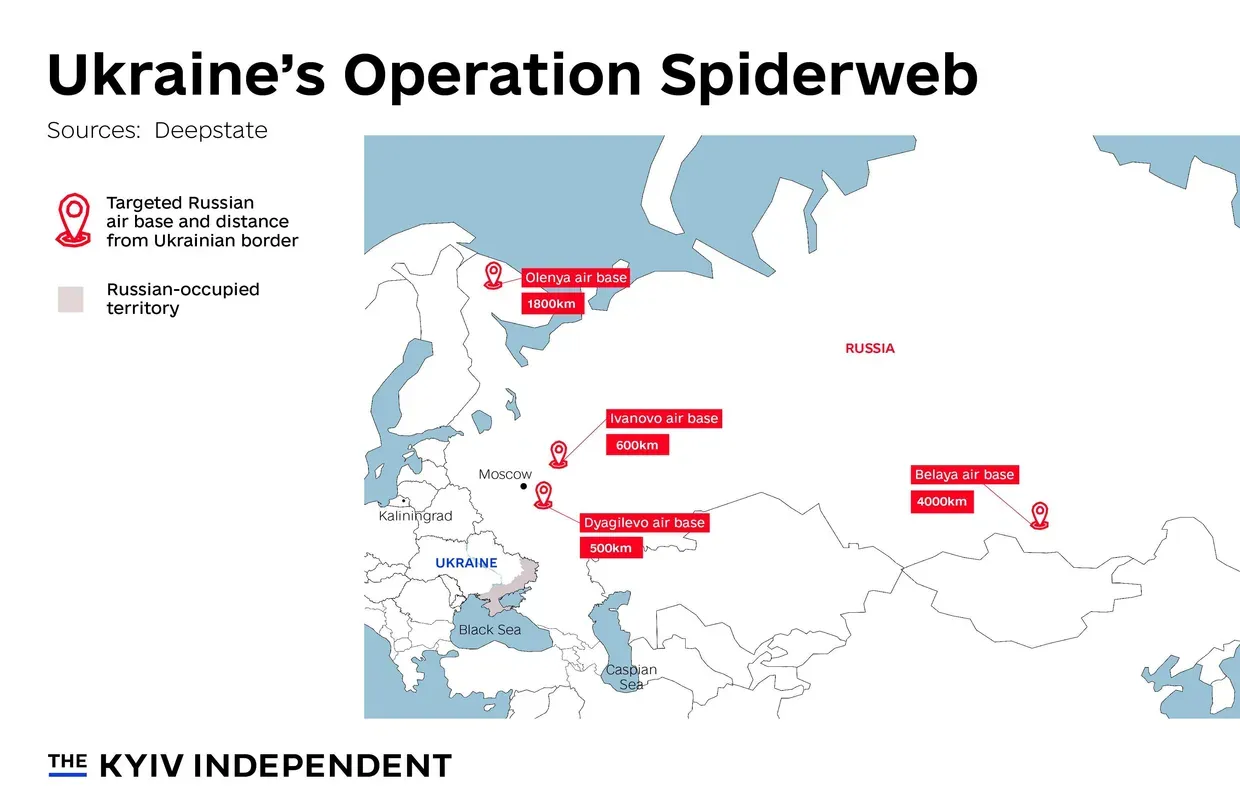
Ukraine’s Operation Spiderweb. (Nizar al-Rifai/The Kyiv Independent) “The SBU is hitting and will hit (Russia) where it considers itself unreachable!” Maliuk said in a statement.
“We are working on new surprises, no less painful than the Operation Spiderweb."
The attack was lauded by Ukrainian leaders and Western partners, with NATO Admiral Pierre Vandier calling it a reinvention of “the Trojan Horse” method with “technical and industrial creativity."
Various satellite imagery released after the attack showed around a dozen destroyed planes. NATO estimates that between 10 and 13 Russian planes were completely destroyed, and more were damaged.
In turn, President Volodymyr Zelensky claimed that roughly half of the 41 targeted planes have been damaged beyond repair. Russia acknowledged damage to its aircraft but claimed all of them will be “restored."
-
Ukrainians among foreign nationals in US targeted for transfer to Guantanamo, WP reports

The Trump administration is preparing to transfer thousands of undocumented foreign nationals, including Ukrainian citizens, to the U.S. military detention facility at Guantanamo Bay in Cuba, the Washington Post reported on June 10, citing undisclosed U.S. official sources.
The infamous prison facility was established by the Bush administration in 2002 to hold suspected terrorists amid the War on Terror. Its operations attracted broad criticism for reports of torture, abuse, and for the facility’s position outside of normal legal frameworks.
The detainees reportedly include individuals from countries such as the United Kingdom, France, Germany, and Ukraine. The move is part of a broader plan to free up capacity at overcrowded domestic facilities.
U.S. officials told the Washington Post that there were no plans to notify the governments of these citizens before their transfer to the facility.
Medical screenings for 9,000 individuals are reportedly underway to assess whether they are physically fit for transfer. Internal documents reviewed by the Washington Post suggest the facility is currently underutilized and could accommodate more detainees.
The Homeland Security Department and the White House declined to comment for the Washington Post on the reporting, which is based on information from multiple anonymous officials and internal documents. A defense official maintained that current operations at the base remain “unchanged” and refused to speculate on “future missions."
Some home countries of the targeted detainees have previously expressed willingness to repatriate their nationals, but have been deemed too slow by U.S. immigration authorities.
The White House has not confirmed the number of Ukrainians affected, and Ukraine’s Foreign Ministry has yet to comment.
The plan to revive Guantanamo as a holding site for mass immigration enforcement is part of President Donald Trump’s broader pledge to ramp up deportations and arrests, with a goal of at least 3,000 arrests daily, according to White House officials.
Previously, the media reported that the Trump administration planned to revoke the temporary legal status of 240,000 Ukrainian refugees who fled Russia’s invasion.
According to a March 6 article by Reuters, the administration aims to cancel refugees' immigration status granted under the Biden-era Uniting for Ukraine program, potentially exposing them to deportation. Although the White House denied the claim, internal Immigration and Customs Enforcement (ICE) documents suggest preparations for fast-tracked removals are underway.
Ukrainian boxer Usyk invites Trump to his home to see Russia’s war firsthand, BBC reports“I advise American President Donald Trump, go to Ukraine and live in my house one week. Only one week … Watch what’s going on every night,” the heavyweight champion said in an interview with BBC Sport.The Kyiv IndependentAbbey Fenbert

-
Russian attacks kill 4, injure 73 across Ukraine over past day
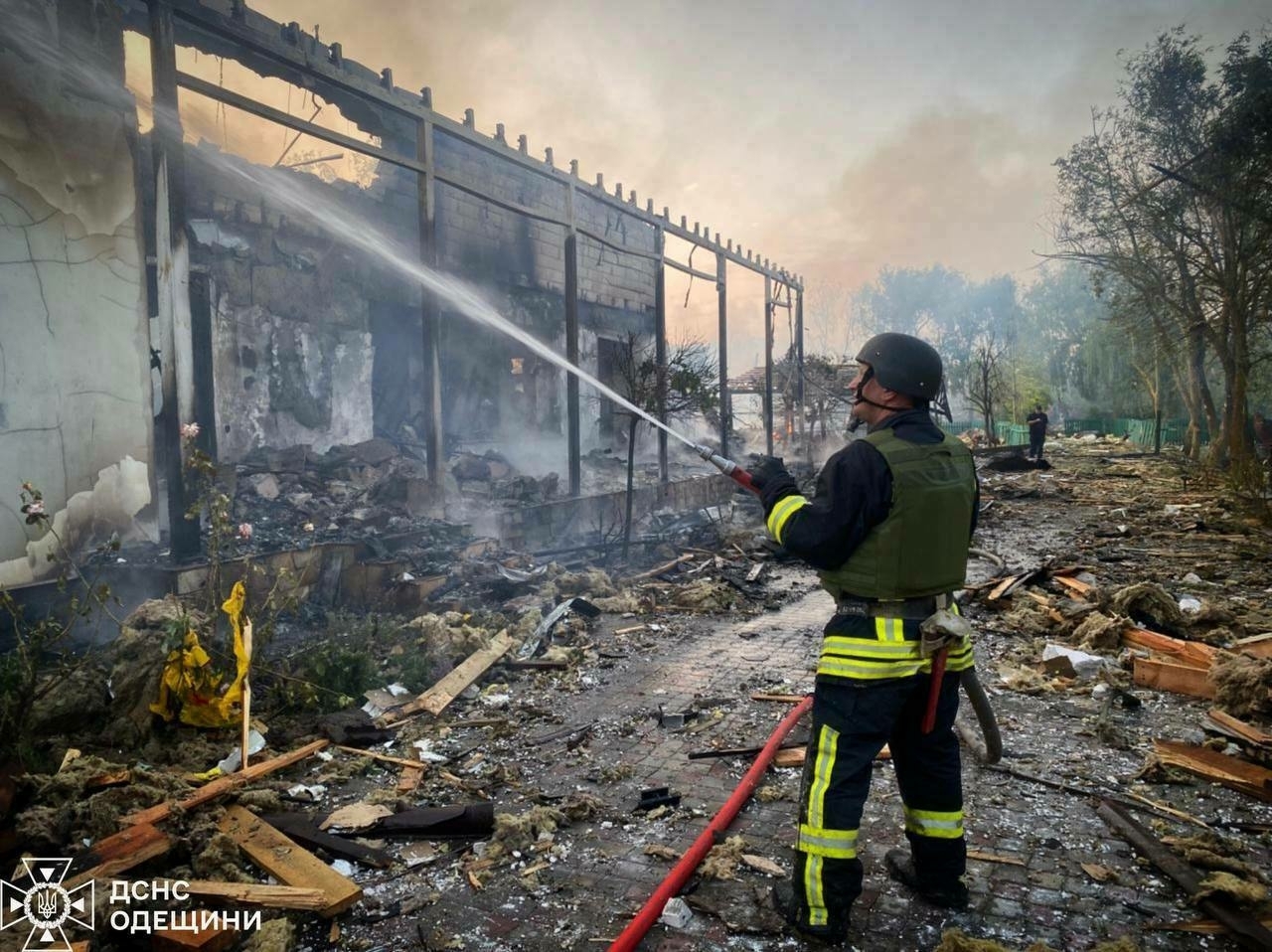
At least four people were killed and 73 injured over the past day as Russian forces launched drone and missile attacks across multiple regions of Ukraine, authorities said on June 11.
Ukraine’s Air Force reported that Russia deployed 85 attack drones, including Shahed-type unmanned aerial vehicles (UAVs) and decoy drones, along with one Iskander-M ballistic missile launched from Russia’s Kursk Oblast.
The main targets were the Kharkiv, Donetsk, and Odesa oblasts. Ukrainian air defenses reportedly shot down 40 drones overnight, while nine drones disappeared from radars or were intercepted by electronic warfare.
In Kharkiv Oblast, three people were killed and 60 injured, including nine children, following drone strikes on residential buildings in Kharkiv city, Governor Oleh Syniehubov said. Five people were injured elsewhere in the region.
In Kherson Oblast, five people were injured in Russian attacks, Governor Oleksandr Prokudin said. A high-rise building and 10 houses were damaged.
In Odesa Oblast, Russian drones struck coastal communities overnight, damaging summer houses, farm buildings, cars, and civilian boats, the State Emergency Service reported. Fires broke out but were reportedly extinguished. No casualties were reported.
In Donetsk Oblast, one civilian was killed in the town of Raiske, and another person was injured, Governor Vadym Filashkin said.
In Zaporizhzhia Oblast, Russian forces carried out 419 attacks on 14 settlements, Governor Ivan Fedorov said. The attack included seven air strikes, 220 drone attacks, and 189 artillery strikes. A civilian vehicle was hit by a drone in Malokaterynivka, injuring two people.
In Dnipropetrovsk Oblast, Russia targeted the Synelnykove and Nikopol districts, Governor Serhii Lysak said. A drone strike sparked a fire at a private enterprise in the Vasylkivska community, destroying a building and farming equipment. In the Nikopol district, artillery and kamikaze drones struck multiple communities, damaging houses and vehicles. No injuries were reported.
In Sumy Oblast, Russian forces launched 14 attacks on border communities, local officials reported. The strikes included mortar and artillery shelling, as well as drone activity. No casualties were reported, but several houses and power lines sustained damage.
Slovak PM threatens to veto 18th sanctions package against Russia over energy concernsSlovak Prime Minister Robert Fico said that he would block additional sanctions unless the EU finds “a real solution to the crisis situation that Slovakia would face following a complete halt in the supply of gas, oil, and nuclear fuel from Russia.”The Kyiv IndependentDmytro Basmat
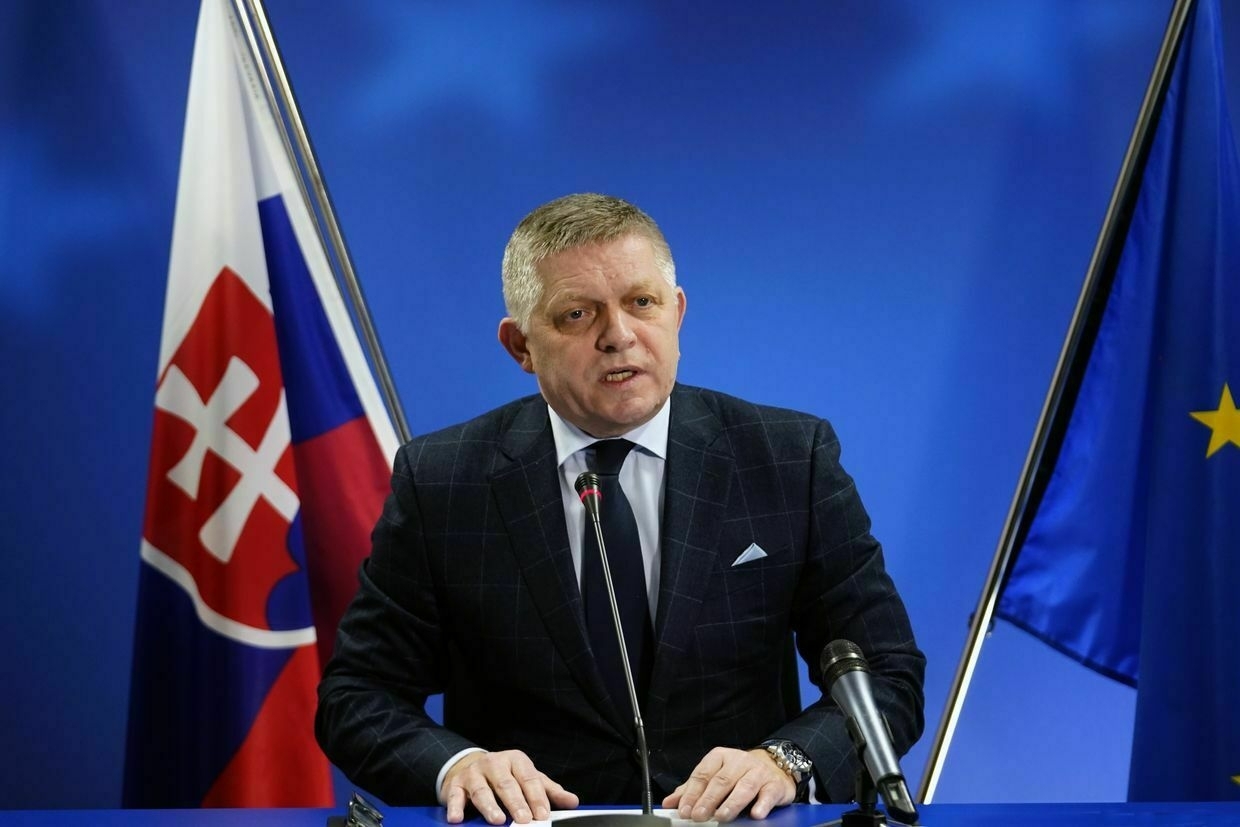
-
US-Russia talks to be held in Moscow 'very soon,' Russian ambassador claims
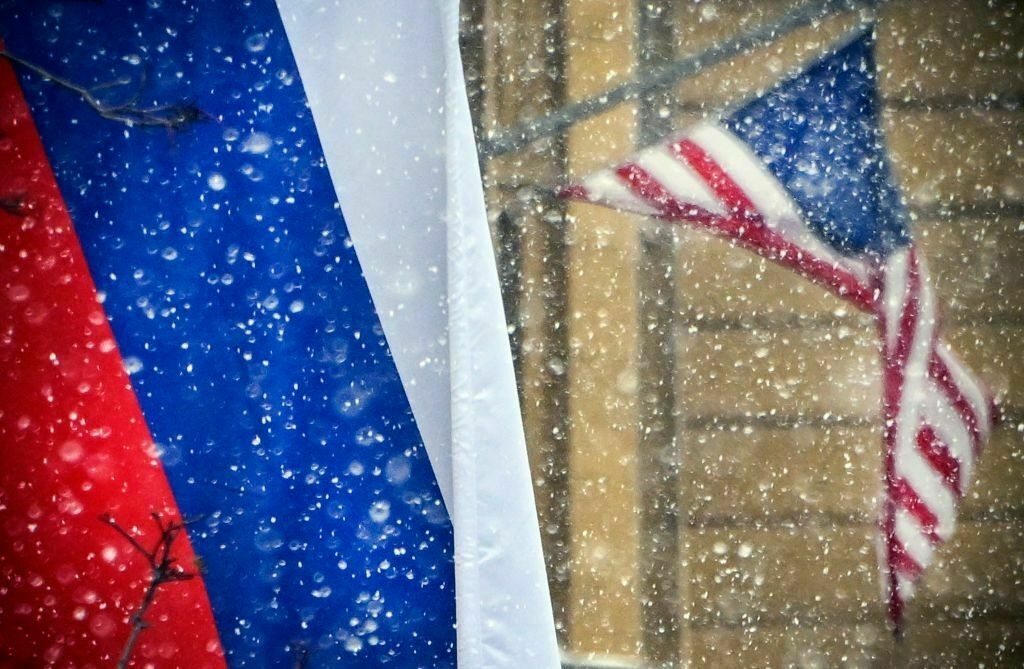
Russian and U.S. delegations will hold talks in Moscow in the near future, Russian Ambassador to the United States Alexander Darchiev said in an interview with state-controlled news agency TASS on June 10.
The meeting would follow a series of previous discussions between the U.S. and Russia that focused on peace efforts in Ukraine and the resumption of bilateral ties.
The first talks since the start of Russia’s full-scale war against Ukraine took place on Feb. 18 in Riyadh, where the sides discussed bilateral relations, a potential presidential meeting, and ending the war.
“I can confirm that the next round of negotiations between the delegations will take place very soon in Moscow,” Darchiev said.
The ambassador noted that during the previous round of talks on April 10 in Istanbul, the two sides agreed to move future consultations to their respective capitals.
The U.S. State Department described the April 10 talks in Istanbul as having a “constructive approach.” The closed-door consultations lasted about six hours and focused on ensuring stable banking services for diplomatic missions. Both delegations exchanged notes on the issue and agreed to continue discussions.
Darchiev also said that Russia is aiming for a model of “non-confrontational coexistence” with the United States and confirmed that the parties have launched negotiations on the return of confiscated Russian diplomatic property.
Other rounds of talks between U.S. and Russia occurred in Istanbul on Feb. 27 and April 10, focusing on diplomatic mission operations and movement of diplomats.
U.S. and Russian delegations also held a 12-hour closed-door session in Riyadh on March 24. The talks centered on a potential ceasefire in the Black Sea and broader military de-escalation.
The diplomatic push continues amid efforts by U.S. President Donald Trump to broker a ceasefire and peace agreement in Ukraine. Trump suggested on June 5 that it may be better to let the conflict continue for now, likening the war to a fight between children that should not be interrupted too quickly.
Kyiv and its allies remain skeptical of Trump’s approach toward peace efforts. President Volodymyr Zelensky has repeatedly called for stronger U.S. action and warned that “America’s silence, and the silence of others around the world, only encourages (Russian President Vladimir) Putin."
A bipartisan sanctions bill, targeting countries that purchase Russian oil and uranium, is awaiting approval in Congress.
Trump quietly pressuring Senate to weaken Russia sanctions, WSJ reportsThe White House reportedly asked Sen. Graham to insert waivers into the bill allowing Trump to choose which entities get sanctioned and changing the word “shall” to “may.”The Kyiv IndependentAbbey Fenbert
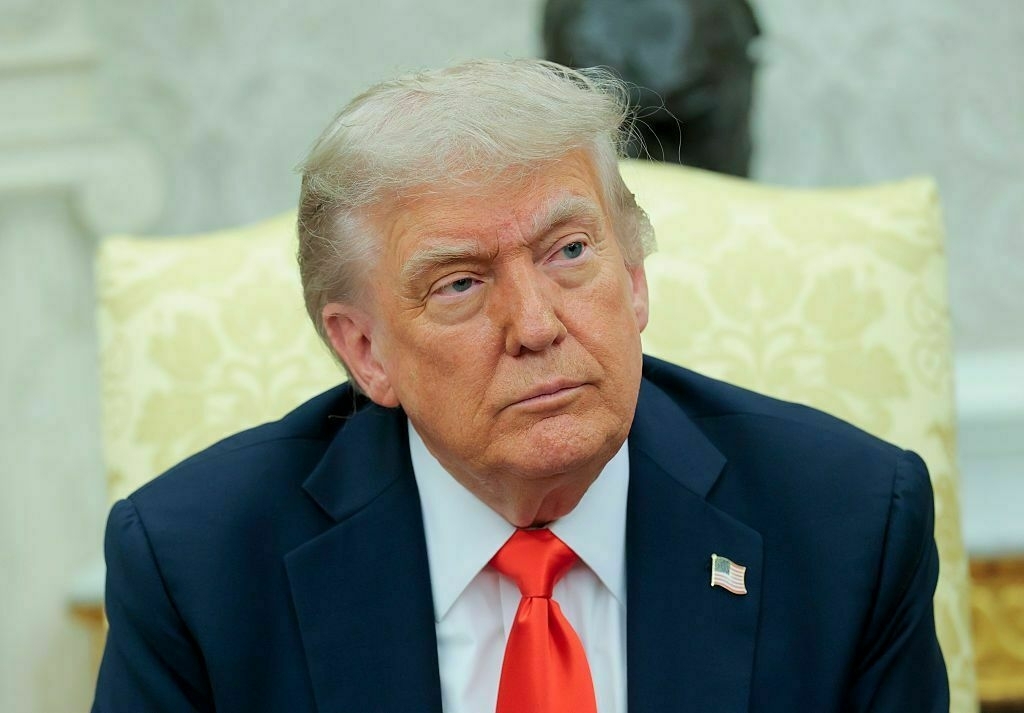
-
General Staff: Russia has lost 999,200 troops in Ukraine since Feb. 24, 2022
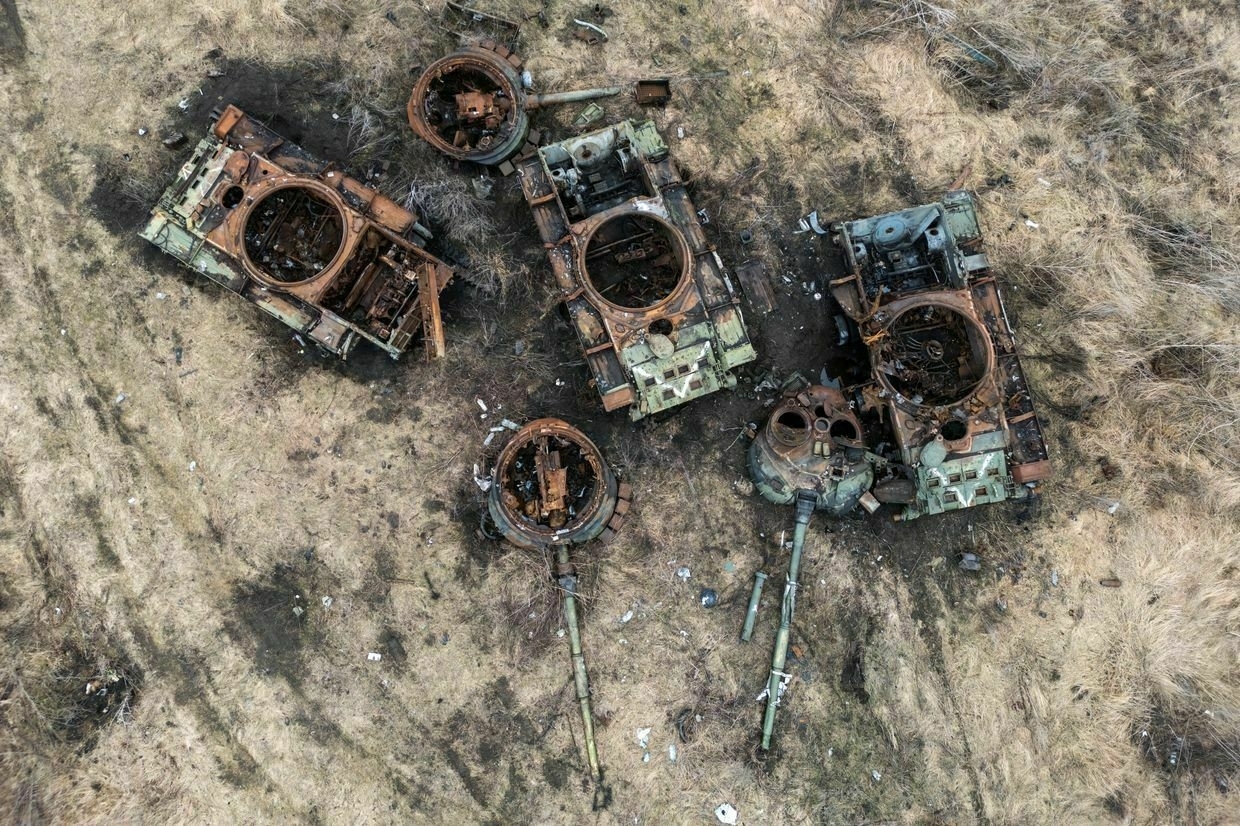
Russia has lost 999,200 troops in Ukraine since the beginning of its full-scale invasion on Feb. 24, 2022, the General Staff of Ukraine’s Armed Forces reported on June 11.
The number includes 1,120 casualties that Russian forces suffered just over the past day.
According to the report, Russia has also lost 10,927 tanks, 22,783 armored fighting vehicles, 51,579 vehicles and fuel tanks, 29,016 artillery systems, 1,413 multiple launch rocket systems, 1,183 air defense systems, 416 airplanes, 337 helicopters, 40,297 drones, 3,337 cruise missiles, 28 ships and boats, and one submarine.
US to cut military aid to Ukraine, Hegseth saysThe U.S. will reduce funding allocated for military assistance to Ukraine in its upcoming defense budget, Defense Secretary Pete Hegseth said in a congressional hearing on June 10.The Kyiv IndependentAbbey Fenbert
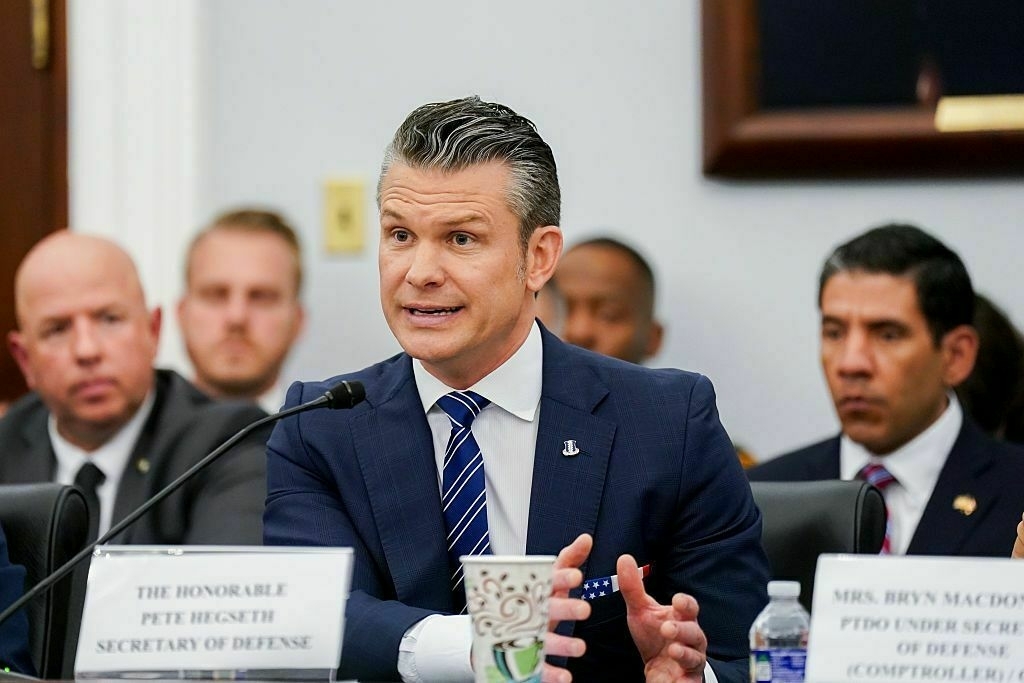
-
Fire, explosions reported at gunpowder plant in Russia's Tambov Oblast amid drone attack
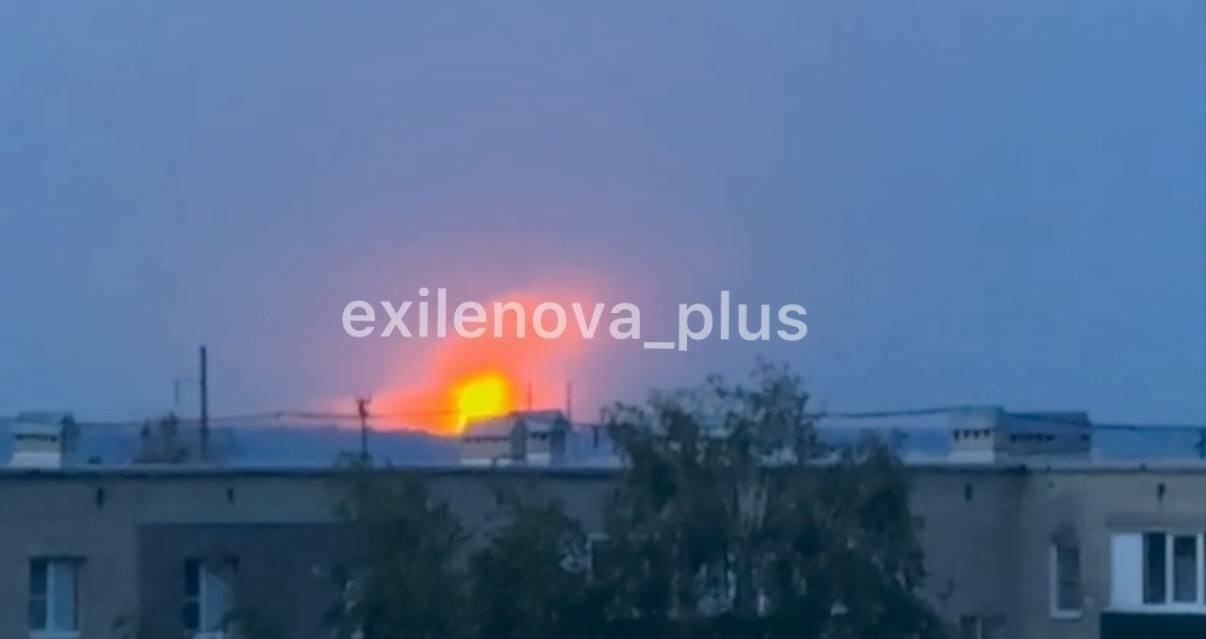
Editor’s note: This is a developing story and is being updated.
A large fire reportedly broke out at a gunpowder plant in the town of Kotovsk in Russia’s Tambov Oblast overnight on June 11, Russian Telegram channels reported.
Residents reported hearing multiple explosions amid a Ukrainian drone attack on the region. Videos posted on social media purportedly show a large fire in the vicinity of the plant.
No information was immediately available as to the extent of damage caused.
Russian state media TASS claimed that a large-scale drone attack on the region was repelled by Russian air defense systems, which resulted in a fire. The outlet did not mention an attack on the plant.
The Kyiv Independent cannot independently verify reports of the attack on the plant. Ukraine’s military has not yet commented on the alleged attack.
0:00/Video of a purported fire at a gunpowder plant in Russia’s Tambov Oblast following a Ukrainian drone atack on June 11, 2025. (ASTRA/Telegram) The gunpowder plant has previously been the target of Ukrainian attack. In July 2024, the facility was struck with a Ukrainian attack drone, a military intelligence source told the Kyiv Independent. The plant was also previously struck in January 2024 and November 2023.
The Tambov gunpowder plant is one of the largest industrial facilities in Russia that manufactures ammunition for the army, including gunpowder for small arms cartridges.
Its production has been reportedly increased by a third since the beginning of Russia’s full-scale invasion of Ukraine. The plant was put on the U.S. sanction list in 2023.
Ukrainian forces regularly conduct drone strikes and sabotage acts on Russian territory, targeting military assets, oil refineries, and industrial facilities.
On the morning of June 10, drones reportedly attacked targets in Russia’s Tatarstan Republic and Leningrad Oblast.
On June 6, drones struck a Russian military plant in nearby Michurinsk, Tambov Oblast.
As peace negotiations stall and Russia refuses the accept a ceasefire, the war has escalated.
Russia intensified aerial assaults on Ukrainian cities in late May, launching some of the heaviest assaults of the full-scale war over three consecutive nights. Less than a week later, Ukraine launched Operation Spiderweb, an audacious mass drone strike that reportedly damaged 41 Russian military planes.
In the days since, Ukraine has continued to target key Russian military assets, launching strikes against missile bases and the Crimean Bridge.
Zelensky calls on West to slash Russian oil price cap in half as strikes on Ukraine escalate“Each of the partners knows what price cap is needed — $30, no higher. Such a price level will mean real pressure on Russia,” President Volodymyr Zelensky said on June 10.The Kyiv IndependentAbbey Fenbert
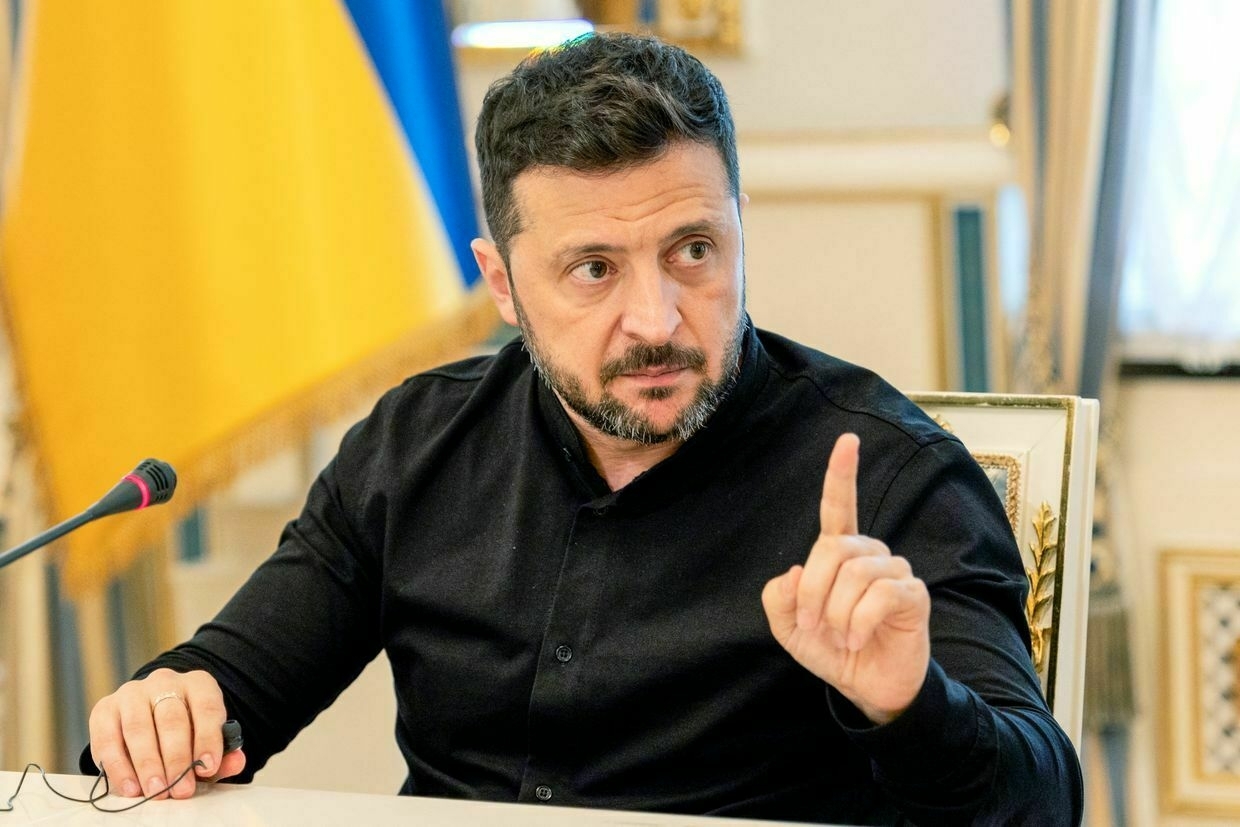
-
Russian jet suspected of violating Finnish airspace, Defense Ministry says
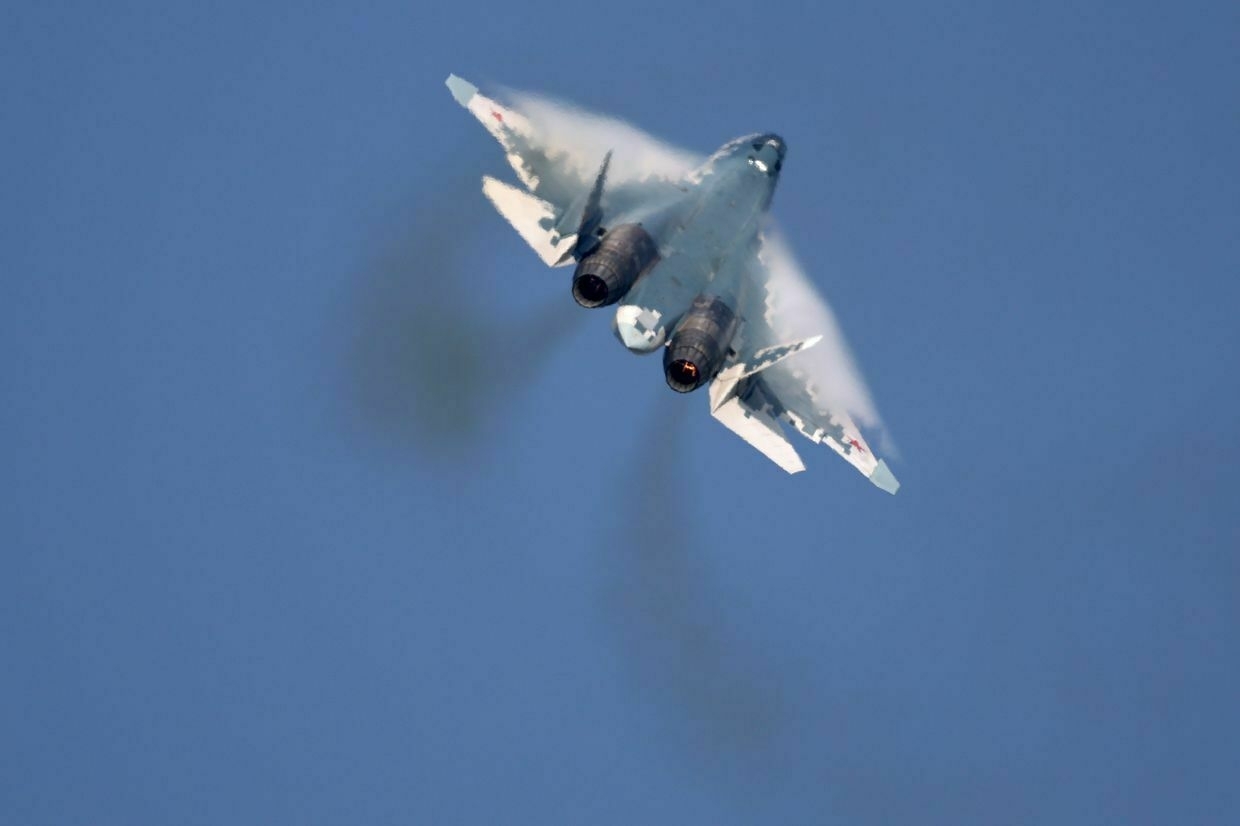
A Russian military aircraft is suspected of violating Finland’s airspace on June 10, the country’s Defense Ministry said in a statement.
“The investigation into the suspect’s airspace breach has been launched immediately,” Finnish Defense Minister Antti Hakkanen said. The Finnish border guard is investigating and will share more information as the probe continues, according to the Finnish Defense Ministry.
The alleged violation occurred near the city of Porvoo, located about 50 km east of Helsinki. The city lies in the country’s far-south, along the Gulf of Finland.
Russia regularly stages provocations on NATO’s eastern flank, which includes Poland, Finland, and the Baltic countries. On May 22, two Russian aircraft violated Finnish airspace, while the day prior Polish fighter jets intercepted a Russian Su-24 bomber in international airspace over the Baltic Sea.
Russian aircraft frequently fly from its exclave, Kaliningrad. The jets often disable their transponders, fail to file flight plans, and do not establish contact with regional air traffic control — a pattern NATO officials describe as high-risk behavior.
Since the start of Russia’s full-scale invasion, NATO officials have increasingly warned Moscow could attack the alliance’s members in the coming years. In anticipation of increased hostilities, Finland has said it expects a Russian military build-up on its borders after the war in Ukraine ends.
On May 19, the New York Times published satellite images which seem to indicate an expansion of military facilities near the Finnish border.
Finland joined NATO in 2023 following the onset of Russia’s full-scale war against Ukraine in February 2022 and shares a 1,300-kilometer (800-mile) border with Russia.
NATO countries in Russia’s vicinity have intensified their preparations for a possible conflict. Poland and the Baltic countries moved to abandon a treaty banning land mines and are strengthening the borders shared with Russia and its ally Belarus while urging higher defense spending across the alliance.
Germany plans expansion of air raid shelters amid growing Russian threats, official says“We must quickly create space for 1 million people,” Ralph Tiesler, the head of the Germany’s Federal Office of Civil Protection and Disaster Assistance told Suddeutsche Zeitung. “Existing structures must be assessed and adapted without delay.”The Kyiv IndependentDmytro Basmat
